Off-Road Cycling Route Between Vukovar and Sarengrad Presented
ZAGREB, June 21, 2020 - A 30-km-long cycling trail running through the countryside and vineyards from Vukovar to Sarengrad near Ilok was presented at the Vucedol Culture Museum, outside Vukovar, earlier this week.
The route is intended for the growing number of cycling tourists in eastern Croatia.
"The Vineyard Trail is an off-road route through the countryside and vineyards which we have designed because the road to Ilok is very busy and is not adapted for use by cycling tourists. The route goes past the Vucedol Culture Museum and many family farms," the head of the Vukovar-Srijem County Department for Tourism and Culture, Marija Budimir, said.
She said that last year the county had spent HRK 490,000 (€65,000) on the promotion of cycling tourism, of which 60% were grants from the Ministry of Tourism.
County prefect Bozo Galic said that Vukovar-Srijem County "has a lot of potential for cycling tourism and with the aid of EU funding we will build infrastructure for the development of this branch of tourism."
President: Football Fans' Clashes in Vukovar Indicate Situation in Town Not Normal
ZAGREB, June 19, 2020 - President Zoran Milanovic said on Friday that conflicts between football fans' groups in Vukovar showed that the situation in that eastern town "is not normal" as local youth was constantly being poisoned, and he called for punishing the perpetrators.
"The perpetrators should be punished and that, I'm sure, is what will happen in this case, which is just an indicator of the situation in the town, which is not normal," Milanovic said in a comment on an incident in Vukovar's neighbourhood of Borovo Naselje, when six people were injured in clashes between supporters of the Dinamo Zagreb football club and those of Partizan Belgrade.
Milanovic does not believe such conflicts are accidental but he does not see how they are linked with the election campaign, noting that they happen all the time.
He said that he was not familiar with the details of the incident but that he did know that back in 2008 there had been an agreement between the then city authorities and representatives of the Serb minority on the official use of the minority's Cyrillic script, after which "the situation has simply regressed to the situation of years ago."
"A series of events in the political life of Vukovar and Croatia have resulted in a radical change of government at all levels, and, unfortunately, a group of people could not imagine their coming back to power without restoring the situation to how it was in 1991," he said.
He said that new generations of young people, notably men, who had been exposed to strong indoctrination on both sides, were now growing up.
"We know what happened in 1991 but 11-12 years ago, when I was just entering the world of politics, the situation in Vukovar looked much better than it is today. I think that one can identify by name the group of people who are responsible for this situation, and the majority is always at least equally responsible as the minority. The majority are we, Croats," he said.
The president would neither support nor criticise comments by politicians regarding the issue of abortion, saying that he was saving his neutrality for the duration of electioneering.
Nevertheless, he noted that his position on the matter is already known and that the right to choose is not only a technical right but also a complex matter.
"The woman is the one to decide. I also respect the more conservative views but I do not agree with them and believe that a line should be drawn somewhere."
As for his predecessor Kolinda Grabar-Kitarovic showing her middle finger as a sign of protest at some positions on the right to abortion of raped women, Milanovic said that such a style was always a method of fight and should be viewed in a certain context.
"The middle finger does not mean anything to me, it can be funny, it can be vulgar. It depends on the context," he said.
Six Injured in Clashes Between Dinamo and Partizan Fans in Vukovar
ZAGREB, June 19, 2020 - Six people were injured in clashes between supporters of the Dinamo Zagreb football club and Partizan Belgrade in Vukovar on Thursday, and they were given treatment in the local hospital.
Local police spokesman Dragoslav Zivkovic said the police had arrested several people and we're looking for other participants in the conflict which occurred in the neighborhood of Borovo Naselje.
According to eyewitnesses, about 20 people participated in the fight between Dinamo's Bad Blue Boys and Partizan's Global (Grave-diggers), using flares, clubs, and other objects.
Vukovar Donates HRK 200,000 to Zagreb
ZAGREB, May 29, 2020 - The eastern city of Vukovar has decided to donate HRK 200,000 (approx. €26,700) to Zagreb to help it remove the consequences of an earthquake that hit the capital city on March 22.
Offering Zagreb congratulations on the occasion of its day, May 31, and the Feast of Our Lady of the Stone Gate, Vukovar City authorities said they hoped reconstruction work in Zagreb would be completed as soon as possible and the city would emerge even more beautiful and stronger than it was before the quake.
Employment in Vukovar: Workers to Make Parts for Boeing and Airbus
The words ''employment in Vukovar'' aren't commonly said or heard. Vukovar, as well as the entire eastern region of Croatia is known more for its workers abandoning it in favour of Germany and Ireland than its workers generating their income there. Vukovar, once ravaged by war, isn't a place that draws much attention from would-be investors or business owners. Is all of that about to finally alter?
As Darko Bicak/Poslovni Dnevnik writes on the 1st of March, 2020, interest in Vukovar has been expressed by a Zagreb-based company which employs 650 people in Croatia, Germany and across the Atlantic in the United States. Just when the factory in Vukovar is due to begin work is unknown so far, but the plans for employment in Vukovar look promising.
Although speculation about the arrival of a company from the aviation industry sector to Vukovar has been rife for some time now, official confirmation of what will likely be a much needed spring in Vukovar's step arrived this week. Namely, Vukovar Mayor Ivan Penava visited the headquarters of Enikon Aerospace in Zagreb, which manufactures plastic parts for aircraft interiors.
Penava announced on the occasion that the employment of fifty people in Vukovar is expected in April, and that, ultimately, 200 workers will be employed by Boeing and Airbus in Croatia's beloved Hero City on the Danube.
It is not yet known exactly when production could begin in Vukovar, as fifty of the first workers will be sent to training after signing their contracts, which will last, as Penava points out, between six and twelve months.
''The arrival of Enikon Aerospace in Vukovar, in addition to the fact that it brings with it the creation of 200 new jobs, also sends us a clear message that new opportunities are being created in terms of acquiring and improving knowledge and skills in the field of this technologically advanced industry, which did not exist here until now. Considering the fact that the needs of Enikon regarding the profile of workers and their qualifications are really diverse, I believe that in this area, we'll find the necessary workforce, which will be trained and improved for all further needs of the company,'' Penava said.
Enikon points out that at first they plan to produce 100 parts per day here, and as many as 1500 later on in the year, meaning increased employment in Vukovar.
''We came to Vukovar exclusively for business reasons. The airline industry is specific and relatively small, and quality and precision are the primary things to take into consideration. Certainly, a commitment is necessary, and there are all these virtues in Croatia,'' said Enikon's Vice President Jakov Baricic.
It's worth recalling that last year, the Austrian FACC bought land in Jakovlje near Zagreb, where it plans to invest thirty million euros in its aircraft parts factory. In the first phase, they plan to hire 600 people, and ultimately it could result in the creation of several thousand new jobs.
Make sure to follow our dedicated business page for much more.
Croatian Railways Building 400 Kilometers of High Speed Track
Croatian Railways is building 400 kilometers of high-speed track and trains on several key routes will be running at speeds of up to 160 km/h within 10 years. The average speed of a current Croatian train is only 58.2 km/h! Only Serbia, Bosnia and Montenegro have railway systems worse than ours.
However, December has proven to be the month of railways when it comes to major projects in this area of Croatian infrastructure, according to Krešimir Žabec/Jutarnji List on December 30, 2019. For years, there have been reports of billions of euros coming to Croatia to upgrade our catastrophic rail network.
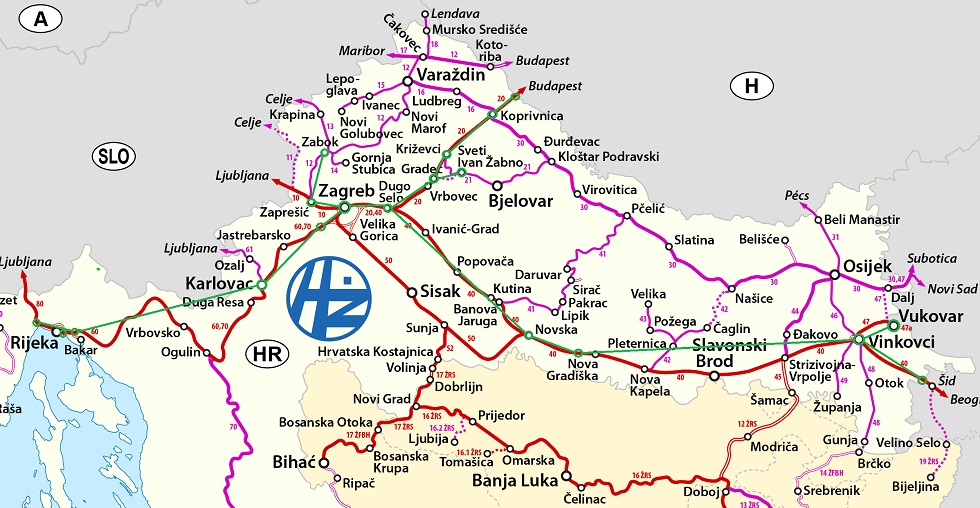
Map of Current and Upcoming Croatian Railways High-Speed Projects | Croatian Railways
Average Speed of Current Croatian Train: 58.2 km/h
The state of railway infrastructure in Croatia is perhaps best illustrated by the indicator of 58.2 kilometers per hour, which is the average speed of trains running in Croatia. Only Serbia, Bosnia and Montenegro have railway systems worse than ours. But until recently, promises of a brighter future for Croatian Railways have sounded like the dreams of politicians which never produced any visible results. However, a turnaround began to take hold this past month.
First New Railway Line in 50 Years Launched in December 2019
First, after 50 years, a new railway line was launched in Croatia: from Gradec to Sveti Ivan Žabno. Then, in Vukovar, a contract was signed with the Spanish company Comsa to upgrade and electrify the Vinkovci - Vukovar railway. Eight years after its launch; the Turkish company Cengiz was selected as contractor for the Križevci - Koprivnica - Hungarian Border section of the project. And a 321 million EUR contract was finally signed to build the Lowland Railway section of Hrvatski Leskovac to Karlovac, which is being co-financed by the European Union.
Three Billion EUR Investment in Croatian Railways
Croatia, the European Union and the World Bank are expected to invest more than 3 billion EUR in designing, renovating and upgrading Croatian railway infrastructure over the next ten years. There are 18 projects in different stages of progress, of which only the Gradec - Sv. Ivan Žabno line has been finished.
Overview of the 250-Kilometer Lowland Railway Project
The international Mediterranean railway corridor connects Rijeka with the Baltic. The Croatian part of this corridor is divided into a section from Zagreb to Rijeka, known as the Lowland Railway, and the section from Zagreb to Botovo (the Hungarian border). It is a 250-kilometer railway line, and only 22 kilometers, from Zagreb to Dugo Selo, are currently two-lane and have been electrified. The estimated value of the modernization and construction of this route is approximately 2.6 billion EUR, and that tab does not include the cost of modernizing the Zagreb hub.
The other sections of this route are in different stages of completion. Work on the 38.2-kilometer Dugo Selo – Križevci section is underway and running about two years behind schedule.
The contract for co-financing and a tender for a contractor have been signed for the section from Hrvatski Leskovac to Karlovac.
Two Options for Most Expensive Lowland Span: Karlovac - Škrljevo
The Hrvatski Leskovac – Karlovac section is connected to the most difficult and expensive span, running from Karlovac to Škrljevo, which is about 150 kilometers long. Construction costs could reach 1.5 billion EUR, but he total cost of will depend on whether the Northern or Southern option is selected. Kupska, the Northern option, is 150 kilometers long, of which 61 kilometers involve tunnels and bridges. Drežnička, the Southern option, is 170 kilometers long with 45 kilometers of tunnels and bridges.
It is unknown at this time whether this section will be put into concession or the European Commission will decide to co-finance the project, due to concern over utilizing Chinese capital. EU funding for Croatia is a more favorable option as it won’t impact public debt. In the event of a concession, a Chinese company would build and finance the project, backed by state guarantees of around 1.5 billion EUR. And it would be difficult for the Croatian state to allow that.

Close-Up of the Zagreb - Hrvatski Leskovac - Karlovac - Škrljevo - Rijeka - Jurdani Line | Croatian Railways
Location Permit and Plans for Škrljevo - Rijeka - Jurdani Section
A location permit has been obtained for the Škrljevo - Rijeka - Jurdani section and the main plans are being drawn, and are being co-financed by the EU with 8.5 million EUR. A final solution is currently being worked on for the Zagreb hub. According to projections, the entire Lowland Railway could be completed by 2030.
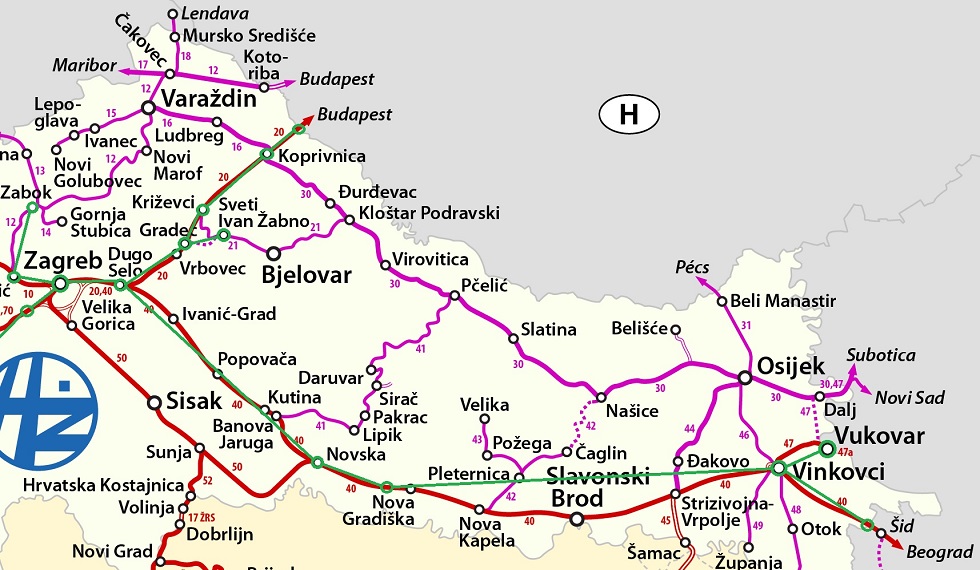
Close-Up of Railway Line Upgrades to Hungary and Serbia | Croatian Railways
Work Progressing on the Zagreb - Serbian Border Railway
Another important international route is railway from Zagreb to the border of Serbia. The sections of Vinkovci – Tovarnik – Serbian Border and Okučani – Novska have been modernized and plans reconstruction and upgrade of the Dugo Selo – Novska section are underway. The estimated price tag for work on this section is 580 million EUR. Project plans for the modernization of the Okučani - Vinkovci section are also in development.
In addition to the construction of the Dugo Selo - Križevci section, two more projects are underway. As part of the modernization and electrification of the Zaprešić - Čakovec railway, work is progressing on the Zaprešić - Zabok section.
Zagreb and Rijeka Port Hubs Undergoing Upgrades
The railway network within the greater Zagreb metropolitan area plays a crucial role in passenger transport. The value of this project, which is being carried out by the Swietelsky construction firm, is estimated at 529 million EUR, with a planned completion date of 2021.
Another important project is the reconstruction and capacity expansion of the Rijeka Brajdica freight railway station.
This project includes the complete reconstruction of the existing nine tracks and the extension of the Sušak railway tunnel to a length of 423 meters. The total value of this project is 35.6 million EUR. This project is extremely important for expanding the capacity of the Port of Rijeka.
Along with these and a few other projects in the upcoming ten years, Croatia is expected to finally upgrade its railway infrastructure. As mentioned in an earlier TCN article, these upgrades will allow train passengers to travel at speeds of 160 kilometers per hour.
Croatian Railways Project Overviews:
Here is an overview of six key railway projects; their statuses and expected dates of completion:
Dugo Selo - Križevci:
Length: 38.2 kilometers
Details: Upgrade of the existing track and construction of the second track.
Contractors: Zagreb Montaža, DIV, Dalekovod Integral
Completed: 65 percent of the financial part of the contract.
Deadline: 48 months
Cost: 196.9 million EUR
Križevci - Koprivnica - Hungarian Border:
Length: 42.6 kilometers
Details: Upgrade of the existing track and construction of the second track.
Contractors: Cengiz (Turkey)
Completed: Signing of construction contract in Spring 2020.
Deadline: 48 months
Cost: 400 million EUR
Vinkovci - Vukovar:
Length: 18.7 kilometers
Details: Track upgrade and electrification.
Contractors: Comsa
Completed: Signed construction contract.
Deadline: 24 months
Cost: 55 million EUR
Hrvatski Leskovac - Karlovac:
Length: 44 kilometers
Details: Upgrade of the existing track and construction of a second track.
Contractors: Tender in process.
Completed: EU approved co-financing with 361 million EUR.
Deadline: TBD
Cost: 450 million EUR
Zaprešić - Zabok:
Length: 23.9 kilometers
Details: Railway modernization and electrification.
Contractors: Swietelsky
Completed: In progress.
Deadline: End of 2021.
Cost: 80.8 million EUR
Rijeka Brajdica:
Length: 4 kilometers
Details: Connecting track to the container terminal of Adriatic port.
Contractors: Kolektor and Euro Asphalt
Completed: In progress.
Deadline: 45 months
Cost: 29.5 million EUR
Follow our Travel page for our continuting coverage of high-speed train track upgrades in Croatia. Train schedules, tickets, route maps and news can be accessed on the Croatian Railways site here.
Bratislava Names Street After Vukovar, Marking the Bond Between Cities
December 8, 2019 - The capital of Slovakia is the first city outside of former Yugoslavia to name a street after the Croatian hero city, Vukovar!
N1 and the Croatian State Office for Croats Abroad report that the honor of unveiling the street nameplate in the Devínska Nová Ves Municipality on Friday went to Vukovar Mayor Ivan Penava and the Mayor of that municipality, Darius Krajčir, who initiated the idea and also has Croatian roots.
"The Danube River connects Bratislava and Vukovar, Vukovar is a symbol of all Croats in the world, and this act is an expression of true respect and friendship towards the heroic city," said Mayor Krajčir, stating that the municipality of Devínska Nová Ves has always been a municipality with a Croatian population, and through history has still been called Croatian.

Central State Office for Croats Abroad
Mayor Penava expressed great gratitude but also pride because this Slovakian street now bears the name of the Croatian hero city.
"This is not just about the street, but about what is behind it. This act speaks to Croats who came here 500 years ago and managed to preserve their language and culture, their consciousness about their nationality and Croatian roots, about the Homeland War, the symbolism and power of Vukovar and its significance for all of the Croatian people. My heart is full to be among my people in such a beautiful setting,” he noted.
The Croatian ambassador to Slovakia, Alexander Heina, also could not hide his satisfaction.
"When a street in Croatia is called Vukovar, it is an act of recognition, but an action we expect. But when something like this happens outside the borders of Croatia, it is something special, something that needs to be recognized, because it proves the truth about the destruction of Vukovar and what happened during the Homeland War outside of Croatia,” Heina emphasized.

Central State Office for Croats Abroad
A reception and commemorative program were organized for guests from Croatia in the Municipality of Devínska Nová Ves along with a visit to the Museum of Croatian Culture, built with donations from the governments of the two countries in Devínsko Novo Selo.
Just a few days ago, another issue was positively resolved for the Croatian national minority in Slovakia, which is a quality and long-term solution to the status of the building of the Museum of Croatian Culture in Slovakia. Societies and associations of the Croatian national minority in Slovakia have thus obtained legal certainty for the long-term use of the building for 99 years, which has become and remains the center of Croatian events, joint meetings and activities. A lasting solution to this issue is of great importance to the Croats in Slovakia.
To read more about made in Croatia, follow TCN's dedicated page.
CORRECTION: The first version of this article stated that Bratislava was the first city outside Croatia to name a street after Vukovar, as is written in the official PR material by the Government Office for Croatians Abroad. We've since fact-checked that statement, and found that Belgrade, Mostar, Skopje, Petrovaradin, and Bačka Palanka (at least those are the towns we're aware of when writing this correction) also have streets named after Vukovar. We are thus correcting that mistake.
Vukovar: How to Honour the Fallen and Assist the Survivors?
November 27, 2019 - As the emotions of the Vukovar week remembering the sacrifices subside for another year, how to continue to honour those who died while assisting those who survived?
I don't think I will ever forget his face.
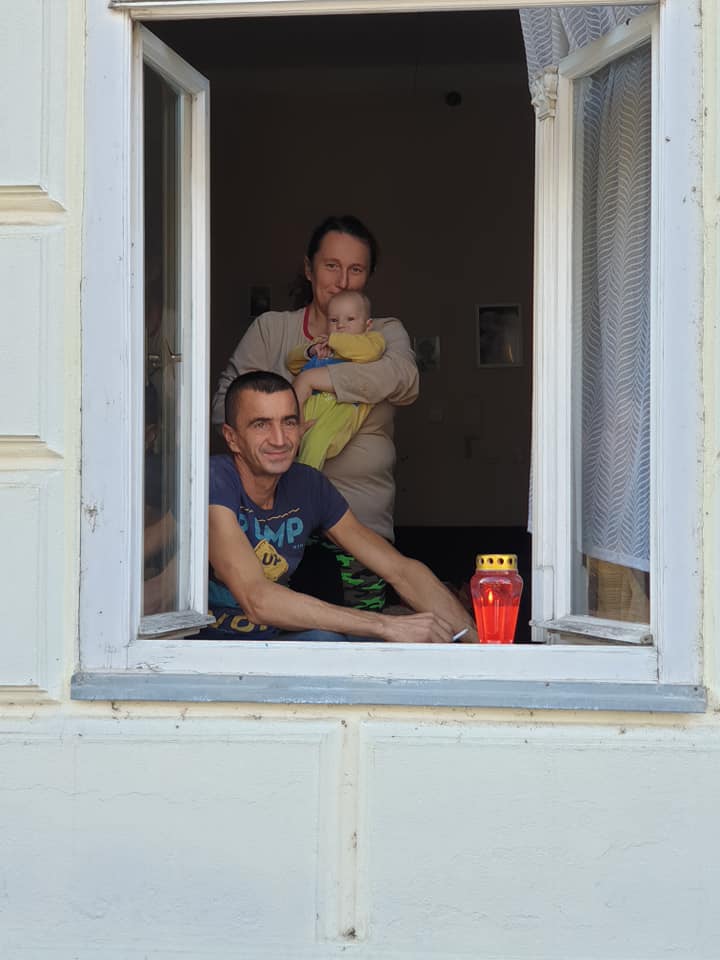
On a day of deep emotion and traumatic memories, one family watched the Vukovar Remembrance Parade pass their window, as tens of thousands took part in the parade from the hospital to the memorial cemetery. The father nodded his assent to requests for photographs.
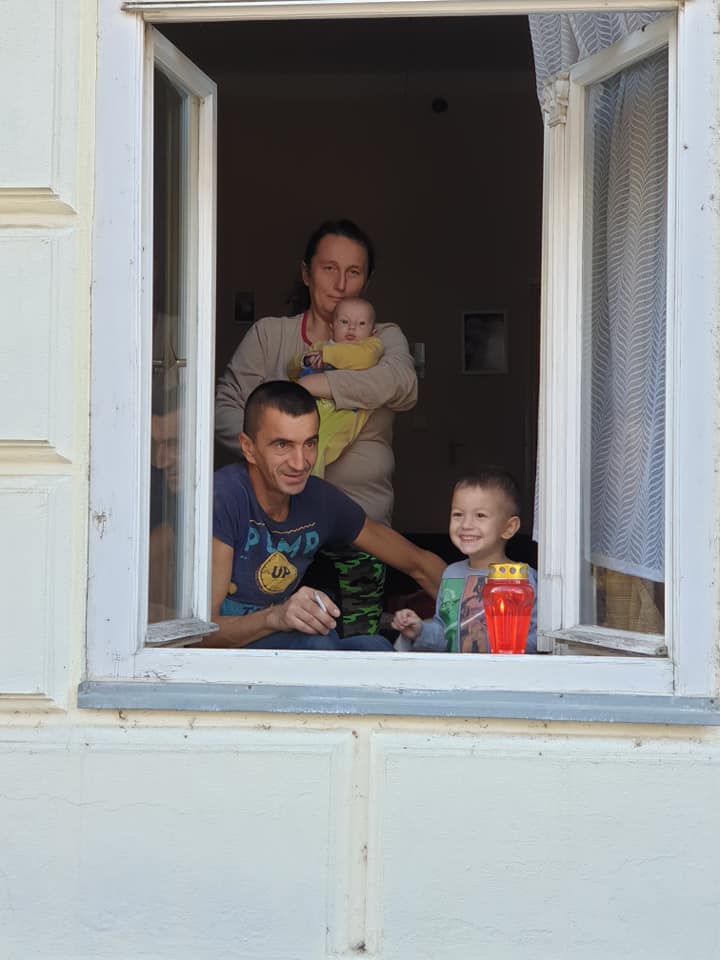
And then he bounced into the room, a bundle of joy on this most solemn of days. Such youthful innocence. May the politicians not fail his generation.
But what can be done by the rest of us as well?
I have been thinking about Vukovar a lot over the last week, and especially about the face of that young boy. So many memories of my time in Rwanda came flooding back, of all the orphans wandering aimlessly around the country in shock.
I have never written about Vukovar before because it is one of the most sensitive of topics in the Croatian psyche, and I didn't know enough about it to write with authority. I decided to take part in the remembrance day parade this year, however, and to document it for, although 30,000 people a year go, there is very little information in English about it. You can read my impressions on this very emotional day here, as well as a truly fascinating barbecue that evening as all the foreign veterans gathered in an English pub in a field somewhere near Vinkovci.
The articles have been broadly well-received, and my inbox and the comments section flooded up with comments and messages of thanks. But there was one comment which struck me the most, from a returnee from Venezuela:
The year we moved to Croatia, we visited Vukovar 5 times. Every time somebody came to visit us, instead of going to the beach, we went to pay our respects to Vukovar. It's a big, open wound. So, so sad. Then and now...
A humble, concrete way to honour those who made the ultimate sacrifice as well as spending money to support the businesses of those who survived and are trying to rebuild their lives.
But the image of the boy would not leave me. And neither have thoughts of Vukovar, or reawakened thoughts of Rwanda.
I have spoken to lots of locals about Vukovar since my return from the parade. Now that I have written about it, I feel courageous enough to ask questions. The general consensus I am finding is that there is considerable anger at the way that the Vukovar memorial has been hijacked by politicians for their own purposes, and the people of Vukovar and their needs have largely been forgotten.
How many years would that innocent look of joy remain on the face of the boy?
Driving down to Trogir the other day, my mind wandered back to Vukovar. I tried to imagine being one of the fallen heroes looking down from Heaven at the November 18 parade 28 years after his death. He would have been proud. Some 30,000 people remembering his sacrifice, a city rebuilt in terms of infrastructure, Vukovar Streets all over the country lined with candelit red lanterns of memory. And all over something called Facebook, Croats posting statuses of Vukovar, Never Forget.
From his elevated position in Heaven, our hero could observe the Adriatic coast in July, a tourism country truly booming. The free and independent Croatia he fought and died for seemingly doing very well.
But then, what's this? Vukovar ten days later. The parade gone, the flags taken down, the people no longer there. A tale of emigration, lack of economic opportunity, a forgotten corner of Croatia, as far from those idyllic Adriatic beaches as one could imagine. And all those Facebook profile statuses also consigned to history to be replaced with something called selfies or pet photos.
And what was there for the boy in all this?
I started to think of my Facebook feed, all that gratitude, all those promises of never forgetting. And while it is great that people are not forgetting, there was nothing for the boy in all that, and the more I thought, the more it seemed that many of these status updates were mostly for the benefit of the poster - to bring them closer to their Croatian roots. For the boy there was nothing.
And I wondered what our fallen hero in heaven would have thought about that?
Or was there a way that people can honour the fallen but also contribute to Vukovar's rebirth in a way that has more of an impact than a Facebook status update?
There is. Something I call Vukovar Week, an idea born from the comment from the Venezuelan returnee above.
There are other ingredients in the Vukovar Week concept. Every child is required to visit Vukovar in 8th grade by law currently (I personally think this is too young). Croatia is introducing a Cro Card scheme (or already has). And the Chamber of Economy has run a campaign called Buy Croatian. Add to these ingredients the fact that most people outside Slavonia and the east have never visited, apart from that school trip, from the diaspora even less.
And yet it is a fascinating, really fascinating place, as I have been reporting in recent weeks. So why not introduce a concept of Vukovar week, a sacrifice (actually a perceived sacrifice, for the rewards will be numerous) the next time you go on holiday in Croatia, locals and diaspora Take a week and HeadOnEast instead. Pay your respects in Vukovar, but also meet the people there, eat their food, drink their coffee and wine, take tours of their countryside.
Vukovar is just a small part of Vukovar Week, however. and it gives visitors a chance to get to know much more about Croatia. I am constantly surprised that so little is known about what is east of Zagreb by locals living on the coast. Osijek, Vukovar and not much else.
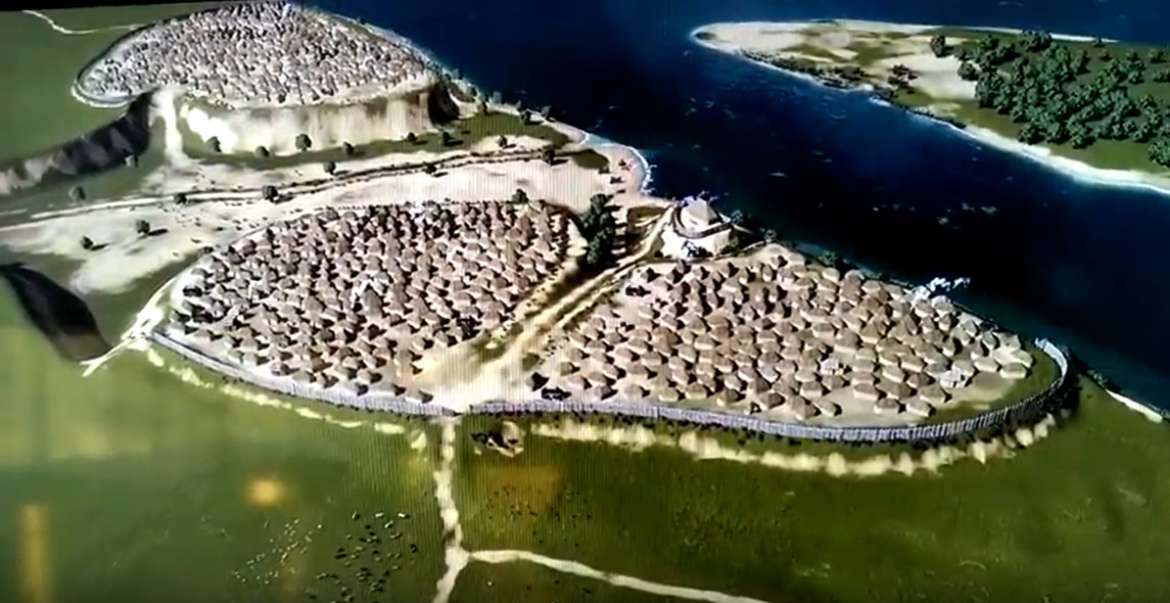
I got SO many messages, for example, when I did the big piece on Vucedol - although people knew something of it, they had no idea it was this amazing. Vucedol is 4km from Vukovar.
A riverboat down the Danube from Vukovar to fabulous Ilok and those incredible wine cellars of Ilocki Podrumi, or north to historic Osijek, the nature park of Kopacki Rit, the wine roads of Baranja, the Lipizzaner horses and cathedral of Djakovo, the oldest continuously inhabited town in all Europe at Vinkocki, the imposing fortress of Slavonski Brad, Papuk nature park and the 800-year wine story from Kutjevo. Just some of the many things available from Vukovar Week. A concrete contribution to the economy of the east, but this is not charity, for what you get in return is worth much more. Here is what we managed to pack into a family weekend recently - incredible.
And, as I drove into Dalmatia and was approaching Trogir. I wondered how practical it could be to make this an official 'thing'. A range of itineraries, after each one of which, you would receive your Vukovar Week card, a card that would entitle you to some discounts on the coast.
And a card that one could post the following November 18 on the Facebook status to show that yes, one will never forget and one is proud and thankful, but also that one has done something concrete to ensure that the sacrifice was not in vain for the surviving families.
And maybe - just maybe - that smile of the boy might stay a little longer. And who knows, one day, that smile might belong to a business owner in Vukovar, who was not forced to emigrate.
Vukovar Remembrance Day Through the Eyes of a Foreign Resident
November 18, 2019 saw Croatia mark Vukovar Remembrance Day, the 28th anniversary of the fall of the City of Heroes during the Homeland War. TCN was there.
Three weeks ago, I was on the island of Hvar helping my father-in-law with the annual olive harvest in the family field.
This week I attended the Vukovar Remembrance Day parade, marking 28 years since the fall of Vukovar after a bloody 87-day siege early in the Homeland War.

Both events are important Croatian traditions and take place in the same country, but they are two events from different worlds. While many Dalmatians can pick their olives and relax until the summer tourist season brings them generous tourism income, life in eastern Croatia could not be more different. Economic hardship, unemployment, emigration, the effects of being at the forefront of the Homeland War still very much in evidence. For a long time I have known that my experience of life in Croatia living on a happy, sunny tourist island was only part of the picture, and visiting Vukovar and taking part in the annual Vukovar Remembrance Day parade has been on my list. This year, finally, the chance to visit came.
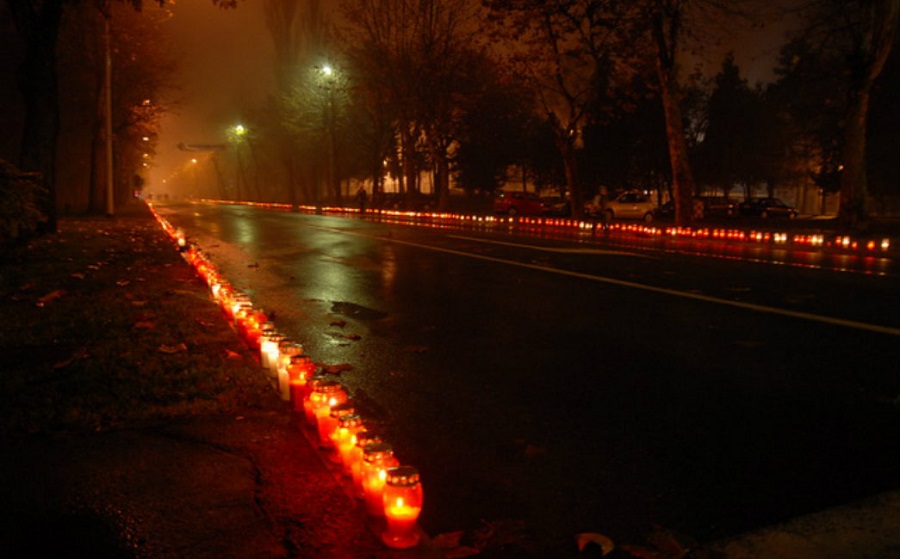
Remembering Vukovar touches every part of the country around the November 18 anniversary, most notably with the candlelit lanterns adorning every Vukovar Street in the country. And there is a Vukovar Street in every town and many villages, including the street I live on in Varazdin County.
Before I continue, a disclaimer. When I started TCN, I received some very good advice from a local. TCN was a great idea, but I should never write about politics, or the portal would be finished. There were other topics which foreigners should not write about as well - religion, war veterans and Vukovar, for we foreigners simply do not understand. It is an argument I understand and actually partly agree with, but on the other hand, if we do not speak about some things more openly, there is no hope of addressing those issues. While researching my trip to Vukovar, I was struck at how little information there was out there in English about what happens at the Vukovar Remembrance Day parade. And so I decided to write a detailed overview of my impressions of the most emotional day in the Croatian calendar. I am sure it will bring attacks from all sides. I am ok with that and with the inevitable trolls who will latch onto this article, for I have long ago realised you don't get branded as a "Tito cock sucking British Jew writing fluff to humanise mass murderers in the Jewish style when socially engineering a people for ruin" by talking about the weather. But I hope it will also explain things a little more and encourage others to make the journey in years to come. It is a very intense but highly rewarding experience.
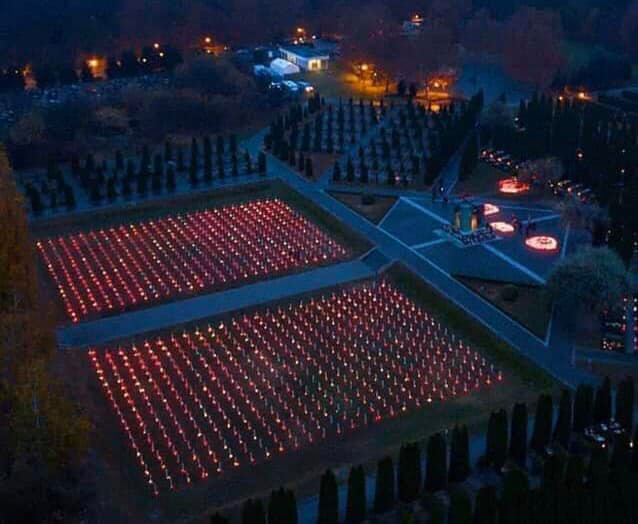
This drone shot of the Vukovar Memorial Cemetery the night before set the scene for what was to come the following day, a 6 km parade from the hospital and museum which became a symbol and focal area of the siege, to a commemoration service at the cemetery, a service attended by the Croatian President, Prime Minister and a host of other dignitaries, as well as tens of thousands of people.
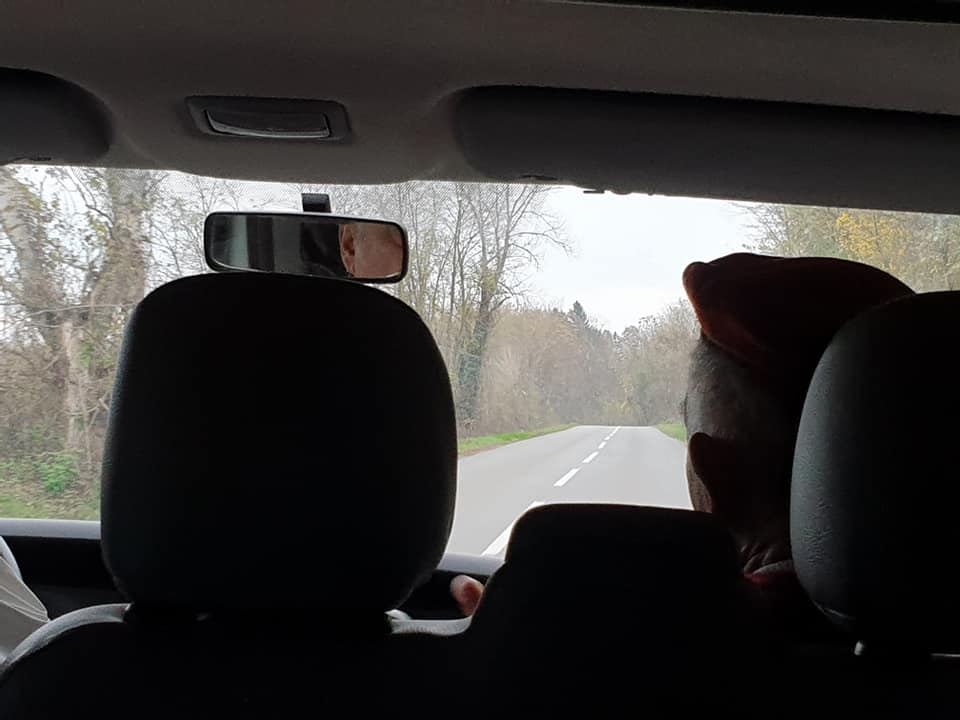
My journey that day actually started in Vinkovci, the oldest continuously inhabited town in Europe, where I was staying with friends. I managed to hook up with the Dubrovnik Trombunjeri troupe, who proved to be not only excellent company, but also very insightful guides. The road we took to Vukovar had been the only access the rest of Croatia had to the city at the height of the attack.
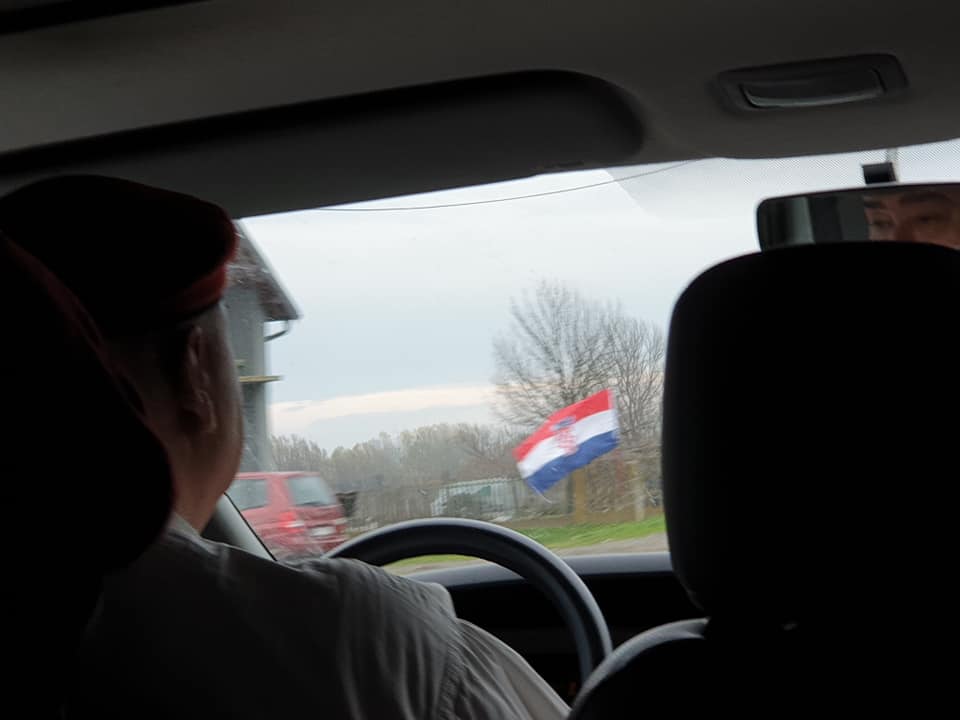
Flags, so many flags adorned the road as we drove past.
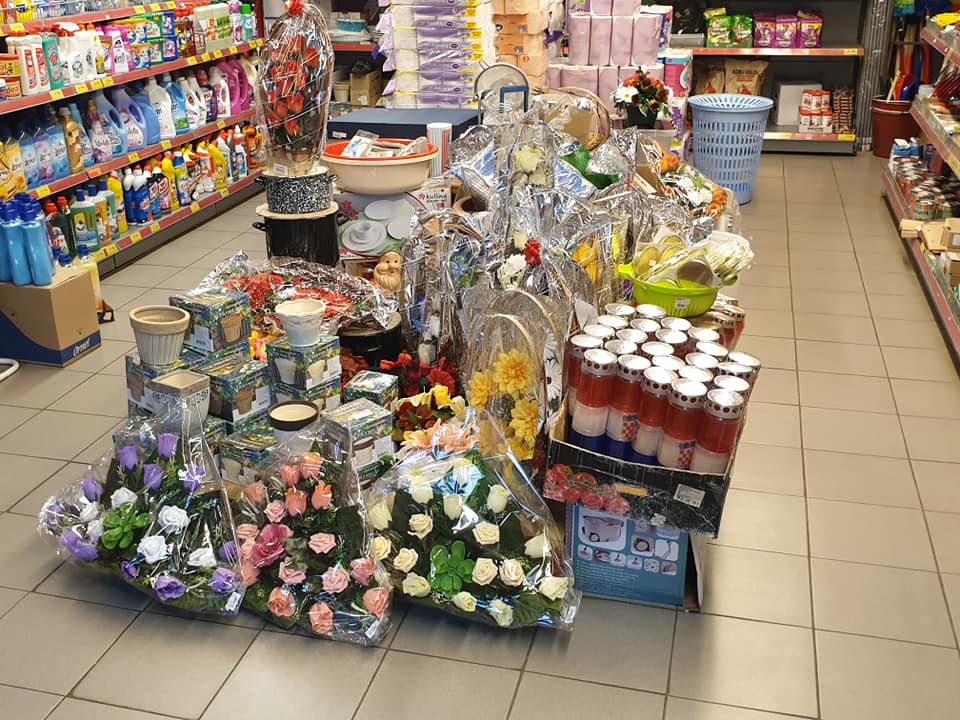
And the local shops brought in additional products for the occasion - lanterns and wreaths.
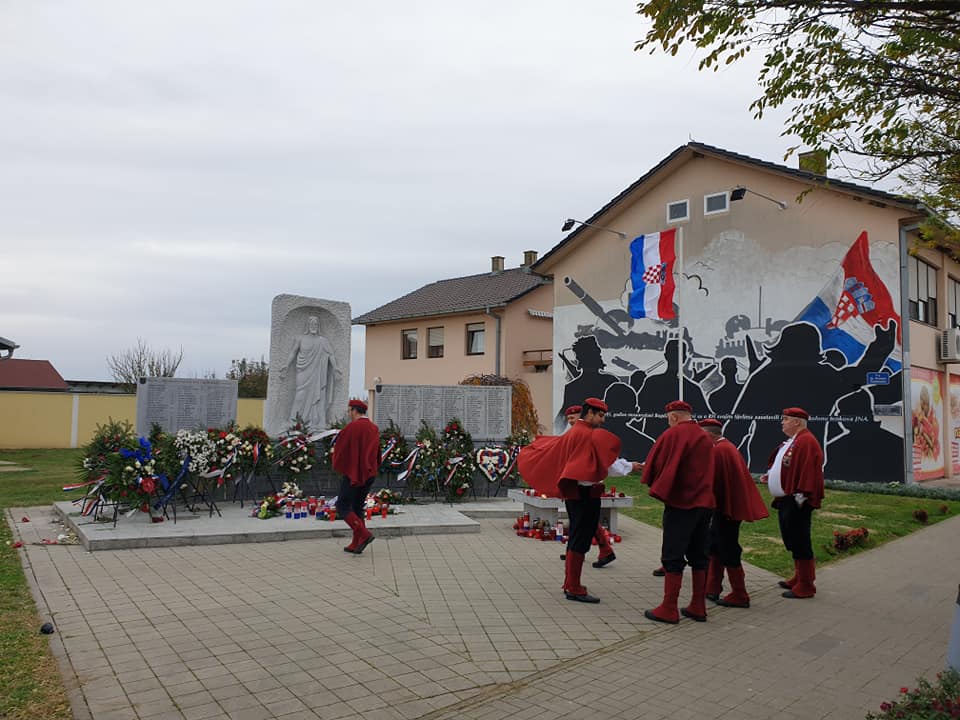
Our first stop was the village of Bogdanovci, where the Trombunjeri stopped to pay their respects at the memorial there.
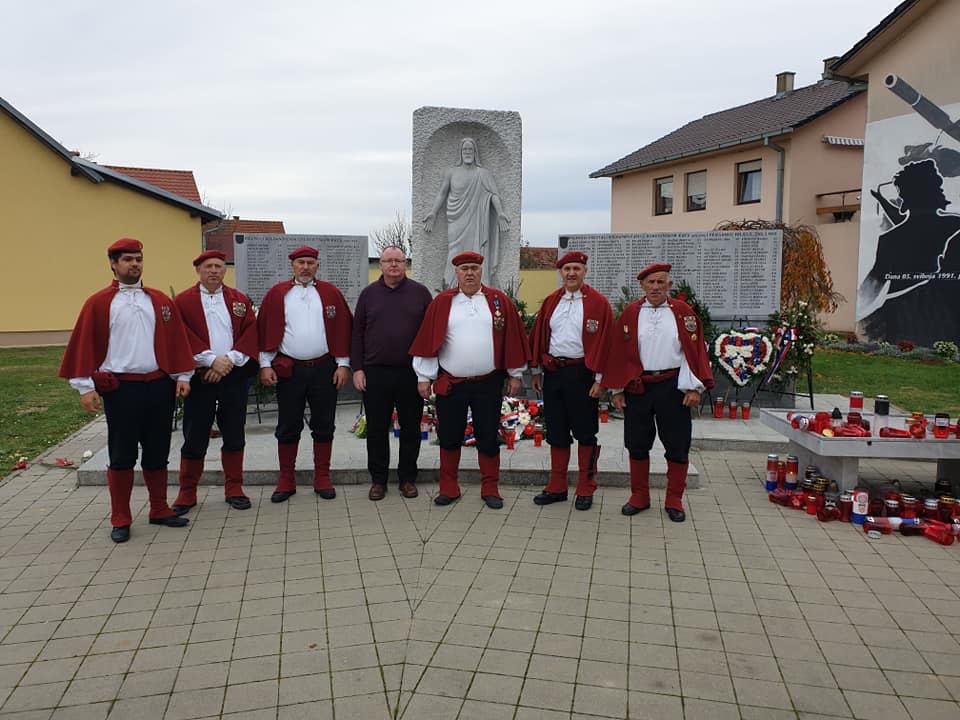
As the lifeline to Vukovar, Bogdanovci was fiercely contested.
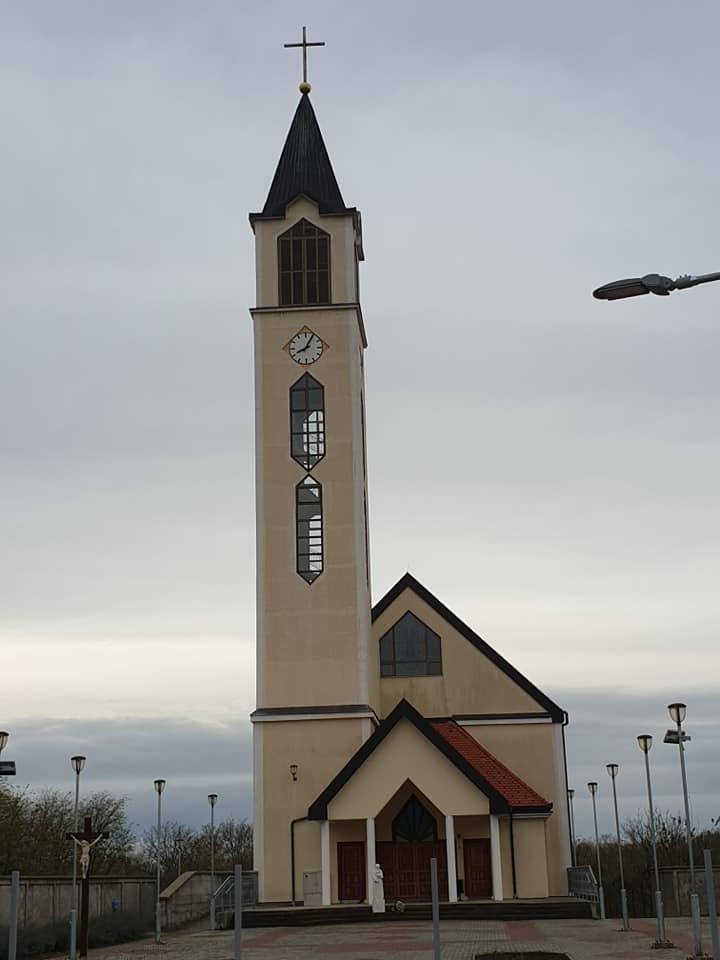
Having fallen, the village was razed, including the church which has since been rebuilt.
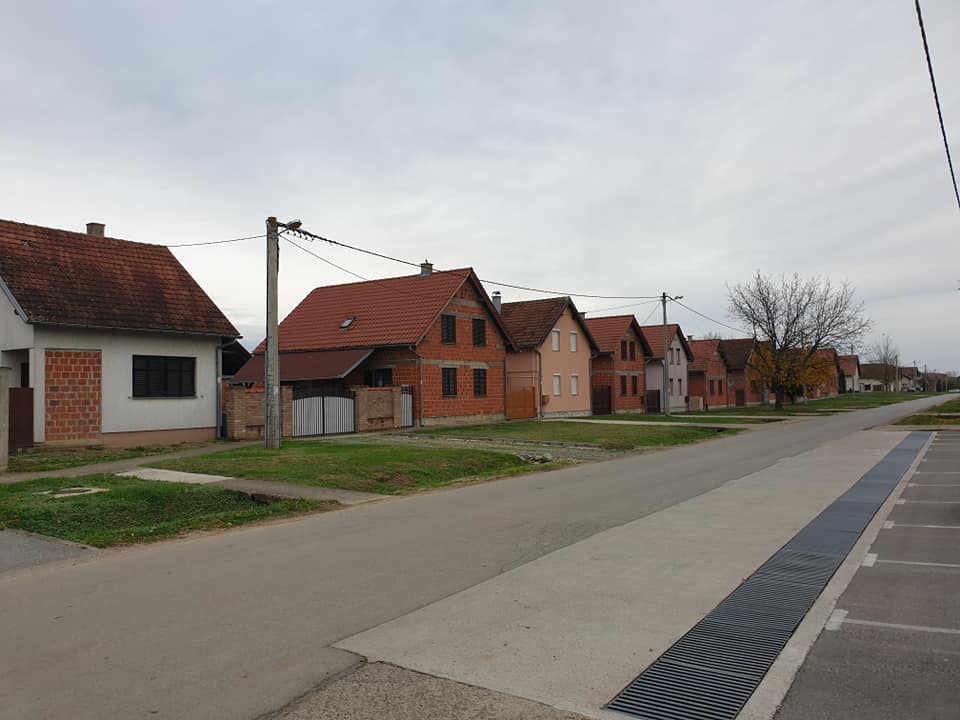
And all the housing - rebuilt by the State.
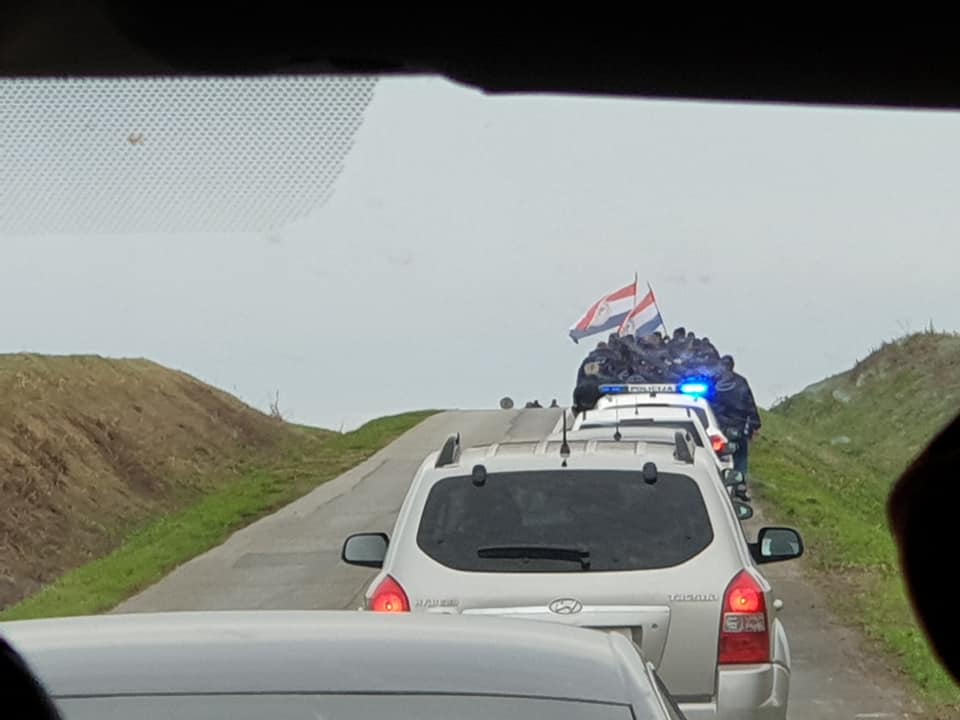
Onward to Vukovar, and then the traffic slowed. I was expecting it to be due to a tractor or something similar, but it was men marching solemnly along to Vukovar.
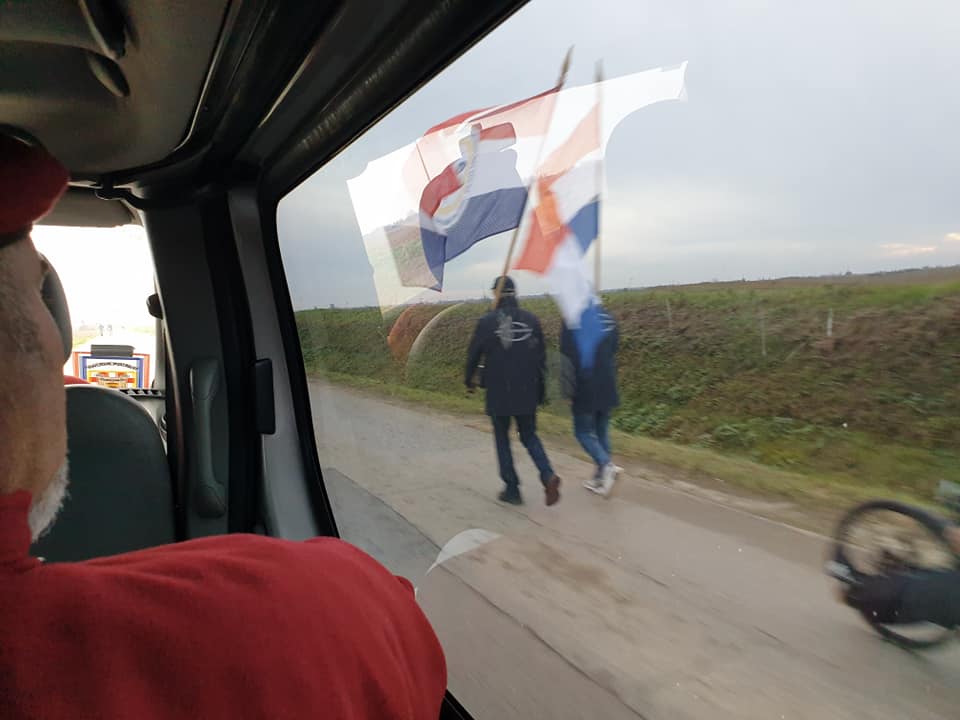
In groups and in pairs.
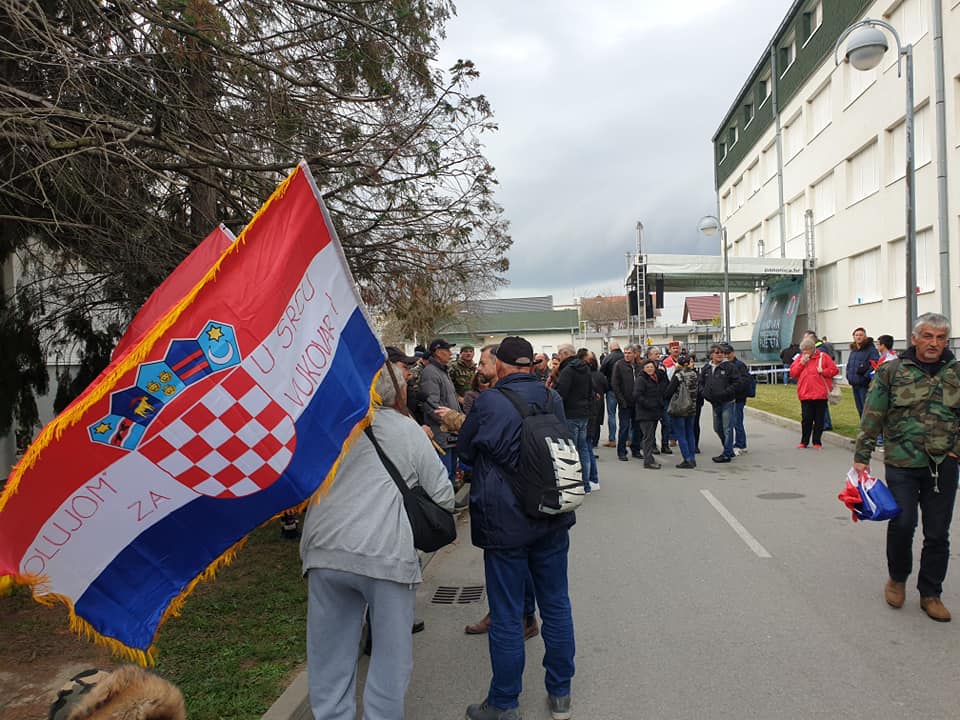
The Trombunjeri went to their official programme, and I wandered towards the centre. So many flags. The atmosphere was festive, the cafes overflowing, and the beers and rakija were already flowing even though it was not yet 9 am. The joy of catching up with friends, the pain of recalling the past - this was going to be an intense day.
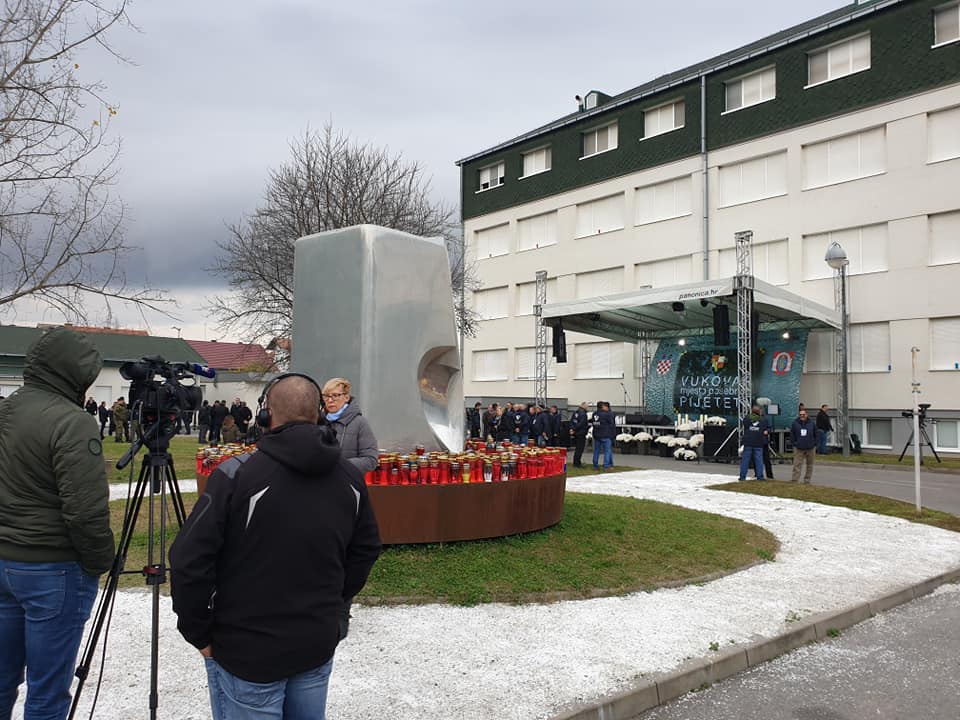
I toured the hospital museum a couple of years ago with members of the diaspora during the Osijek diaspora conference - it was harrowing. This is where the ceremony would begin. National television was broadcasting everything live, and the crowds had already built up. I decided to find a spot in the crowd away from the hospital to film the parade when it started.

A special mention for the police and organisers. The policing was exceptional all day, from crowd control to traffic management. With so many people descending on the town, it could easily have descended into chaos, but it was superbly organised.
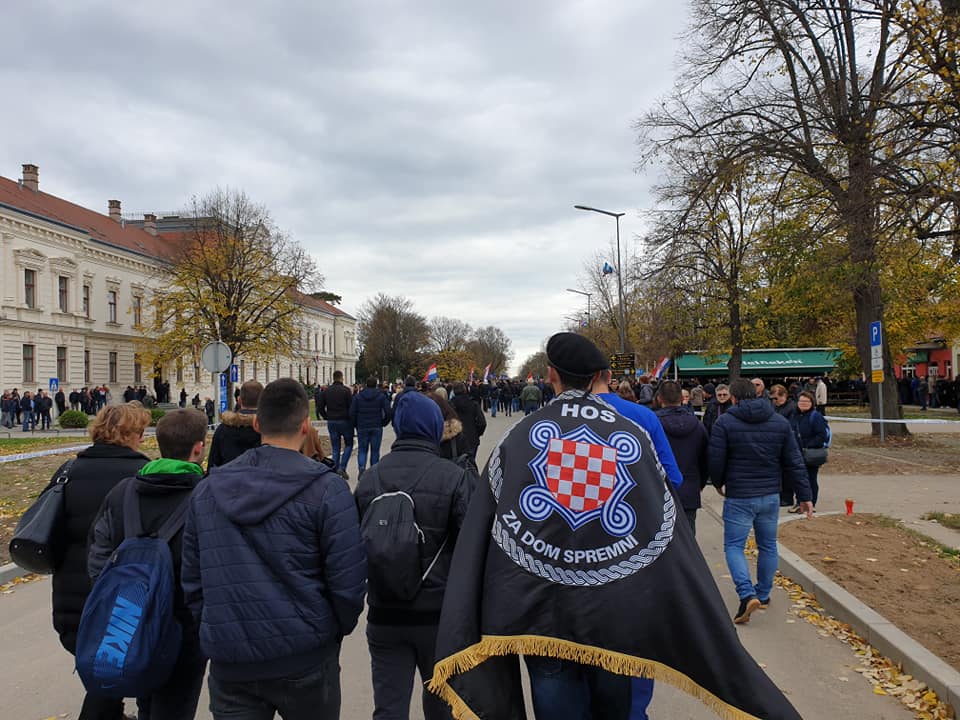
The controversial 'Za Dom Spremni' slogan, part of the HOS insignia, was very evident. I mention it not to start a debate, as the issue is complex, but simply to document it. HOS were the heroic defenders of Vukovar, and so the slogan is not considered controversial there.
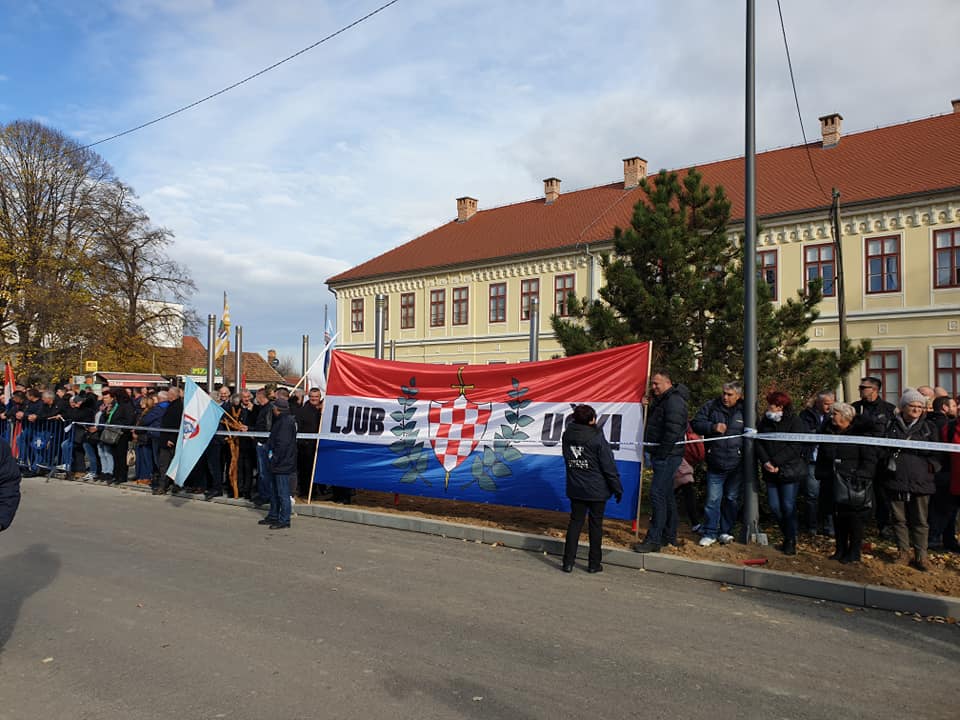
The flags were everywhere, and from every part of Croatia, and Herzegovina.
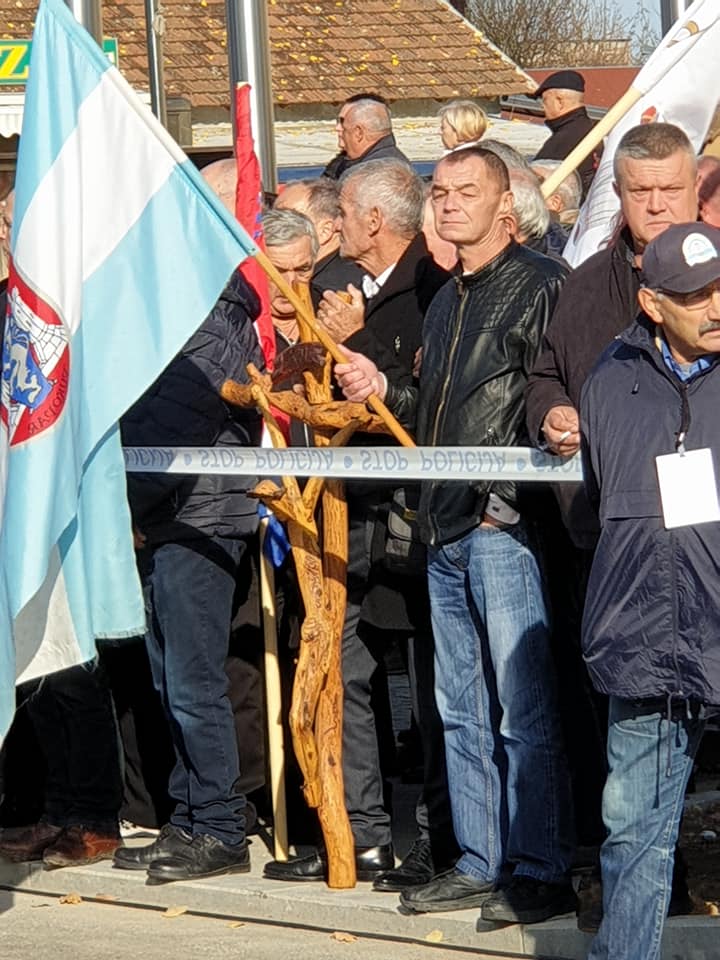
This old man with this carved wooden cross caught my attention.
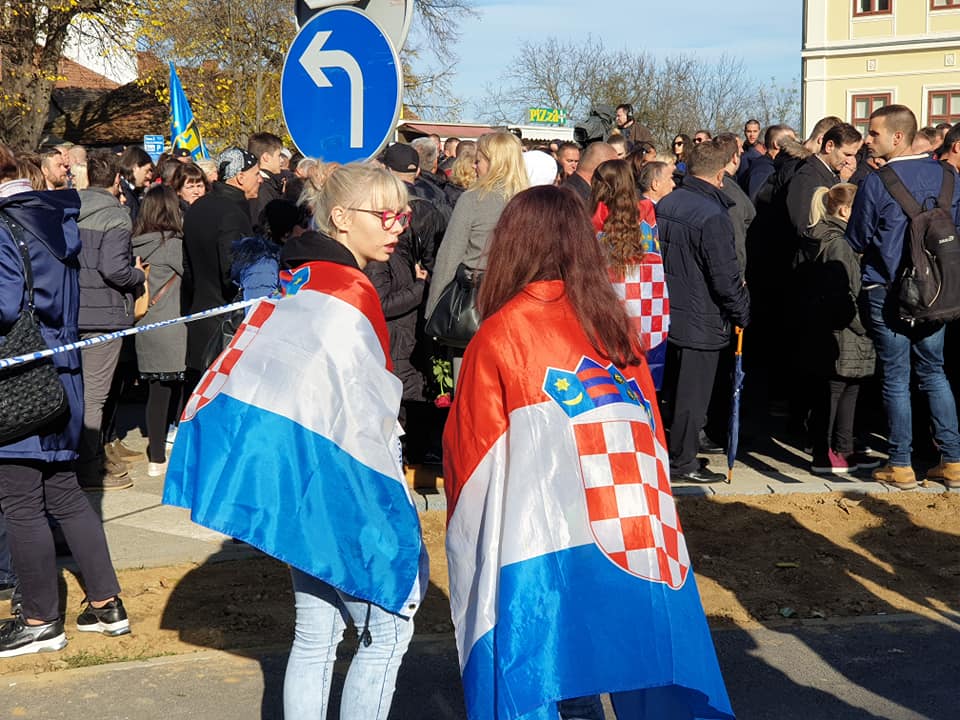
Flags everywhere.
And then things began. The Croatian National Anthem is one of the most powerful I know, arousing emotions where the British equivalent never could. God Save the Queen just doesn't compare. Put the anthem in an emotionally charged situation such as Vukovar Remembrance Day, and the effect is exponential.
And so they came. The first of thousands, including the bright colours and banners of the Sinj Alka, Dubrovnik Trombunjeri, troupes from Klis, Pozega, Karlovac and many others.
Followed by the military brigades.

And onward we walked, through the historic centre of Vukovar, past the Radio Vukovar building, where the famous reporting of Sinisa Glavasevic was being played on the loudspeaker.
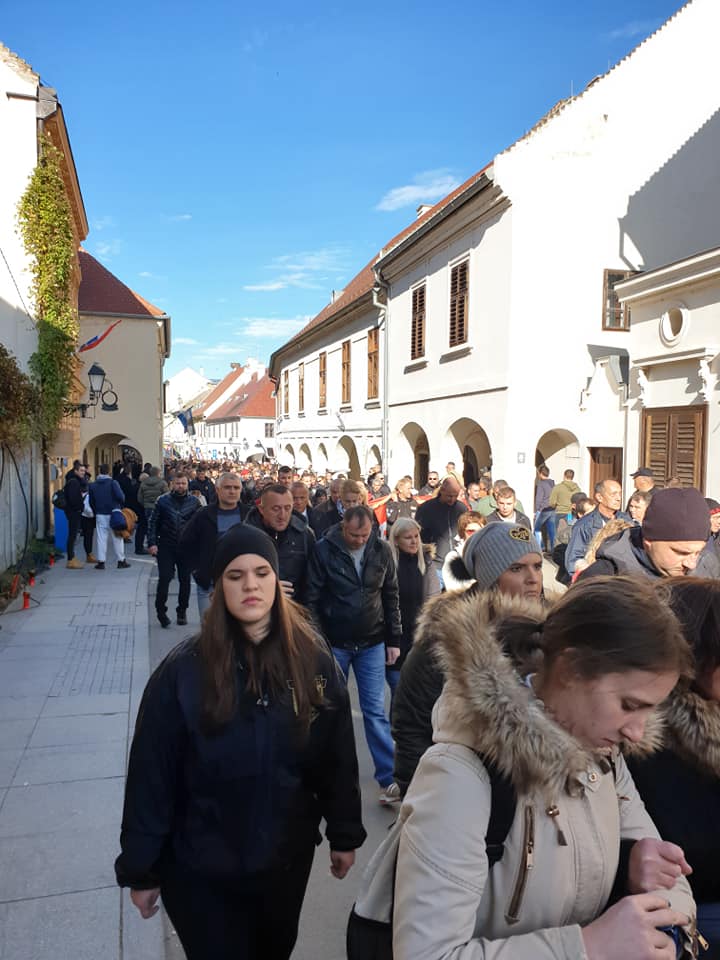
Thousands.
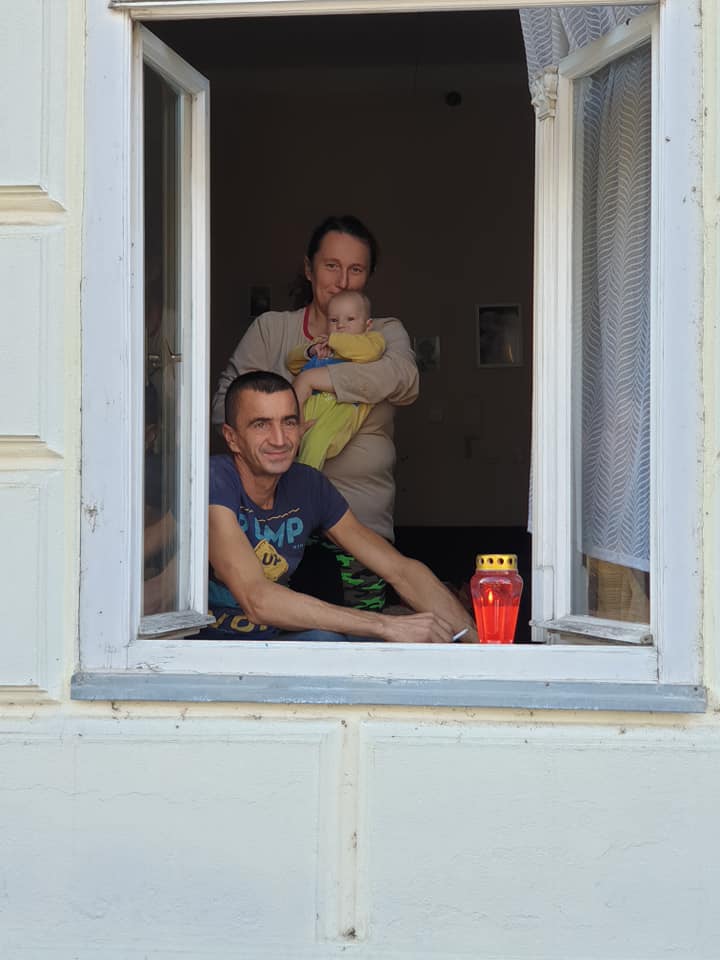
And then I saw - and captured - the two images which will stay with me the most from this intense day. Walking along the high street, a few people were taking photos of this family, who were watching the parade from their living room. I asked if I could take a picture, and the father motioned his assent. A powerful picture, but one which was about to get more powerful...
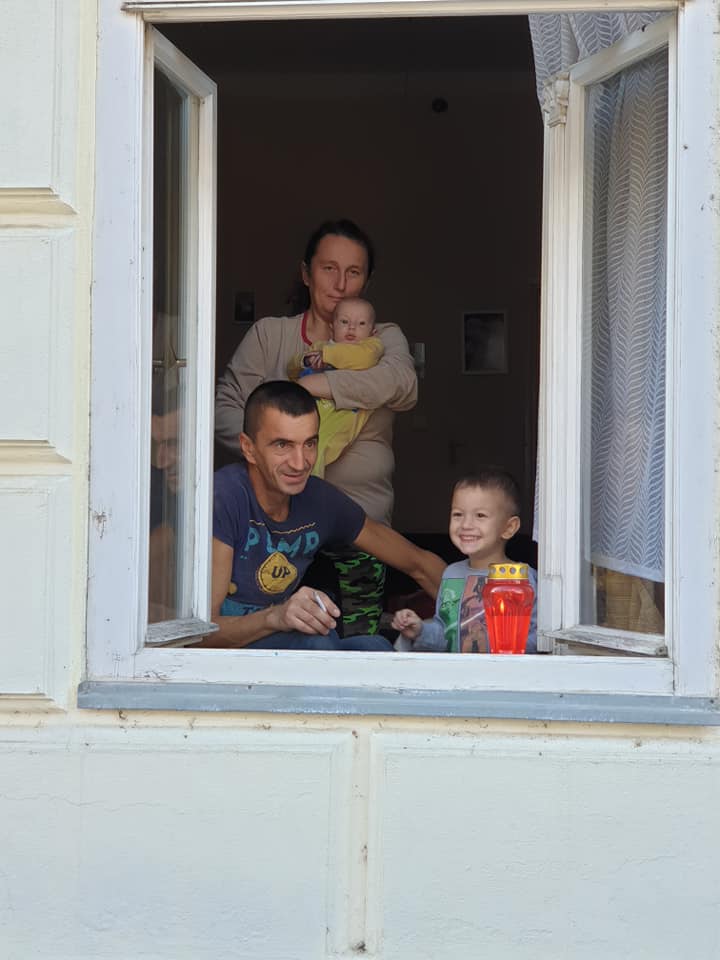
... as a little bundle of joy, totally oblivious to what was happening, burst into the room. The next generation of Vukovar residents - may the politicians not fail him and his generation.
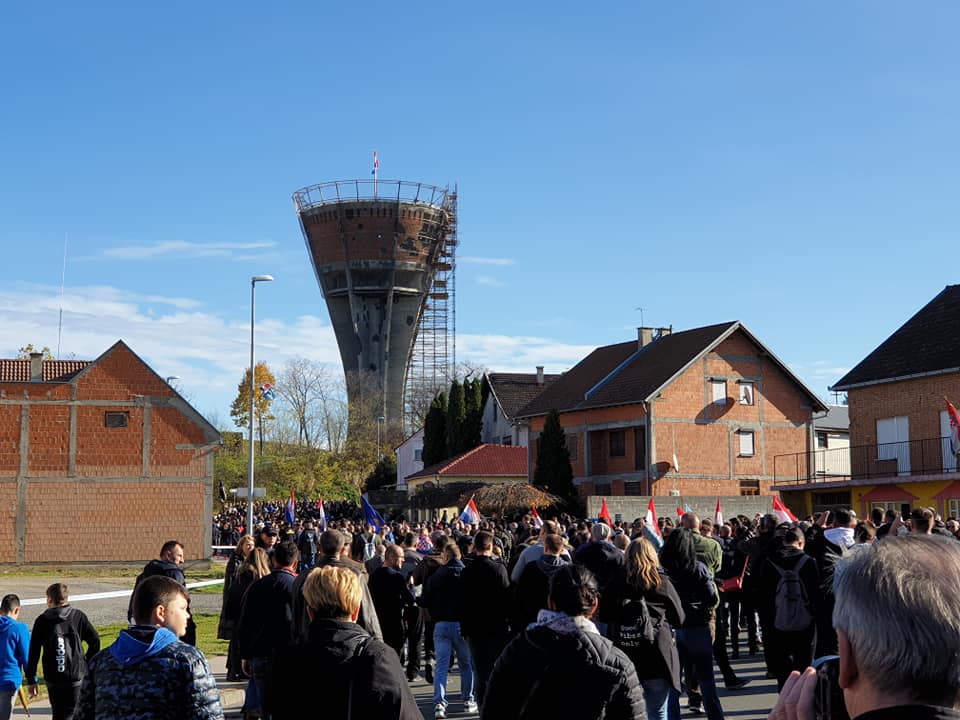
Onwards past the iconic Vukovar water tower.

Thousands.
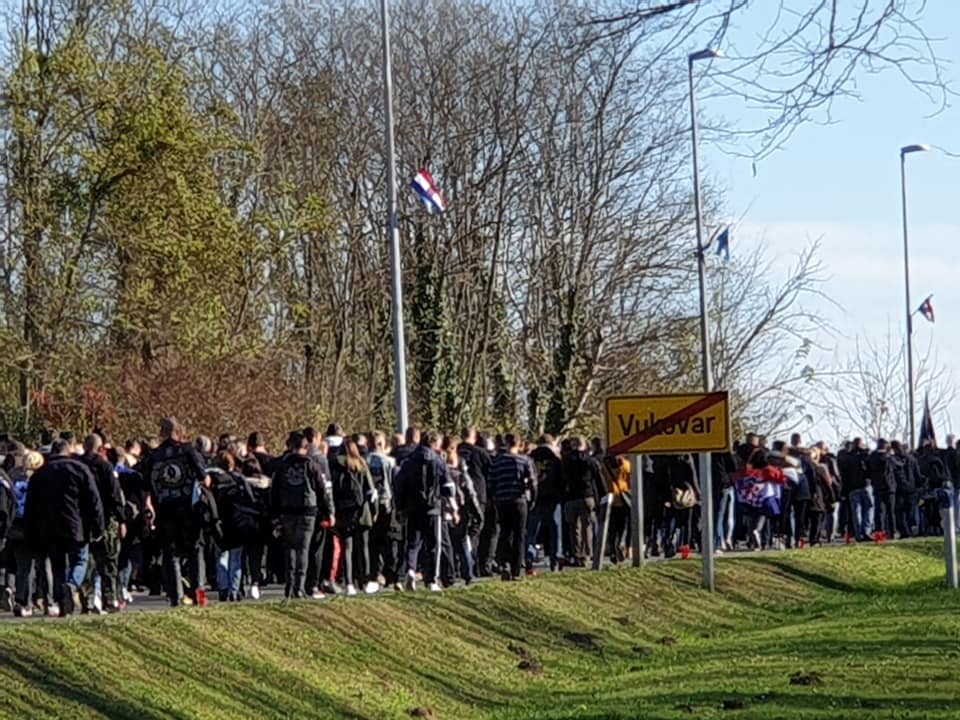
Onward, outside the city limits.
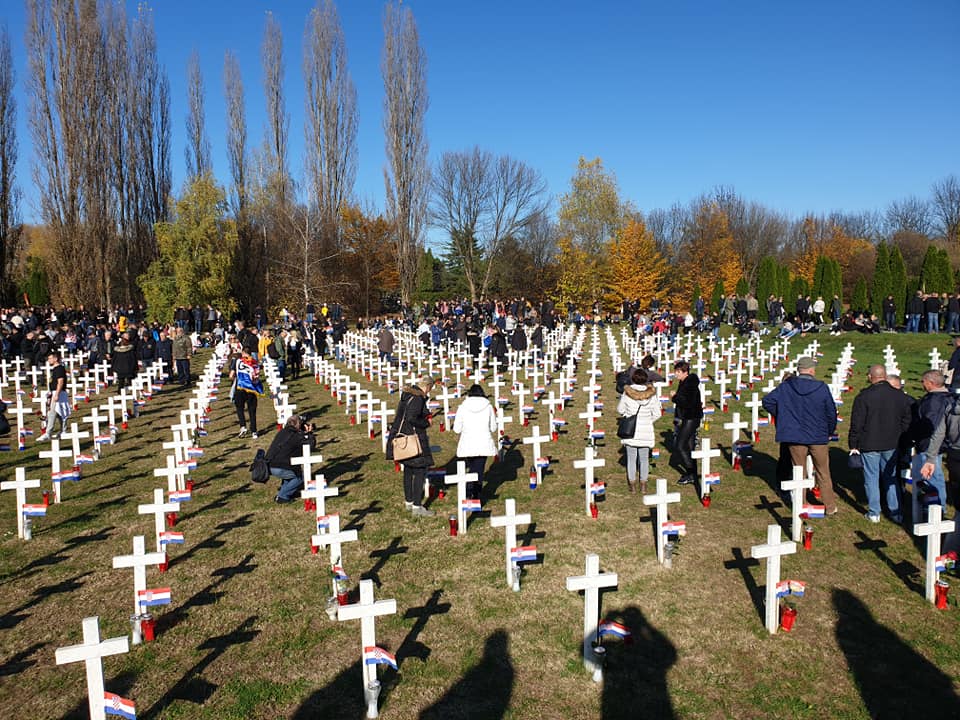
And into the final destination, the Vukovar Memorial Cemetery. Humbling.

I was late for the laying of the wreath, but here is a little of the atmosphere near the eternal flame.

The traditional troupes from all over Croatia posed for their photographs.
There was a commemorative service which was broadcast live on television. I went instead with the Trombunjeri and the others back into town by bus. The trip took us on a detour through Ovcara, scene of a large massacre after the fall of the town. From there, the Croatian army had invited anyone who wanted to come to a lunch of 'grah' (beans) and so we headed to the tents by the museum there, which also housed some incredible examples of the weaponry used during the conflict.
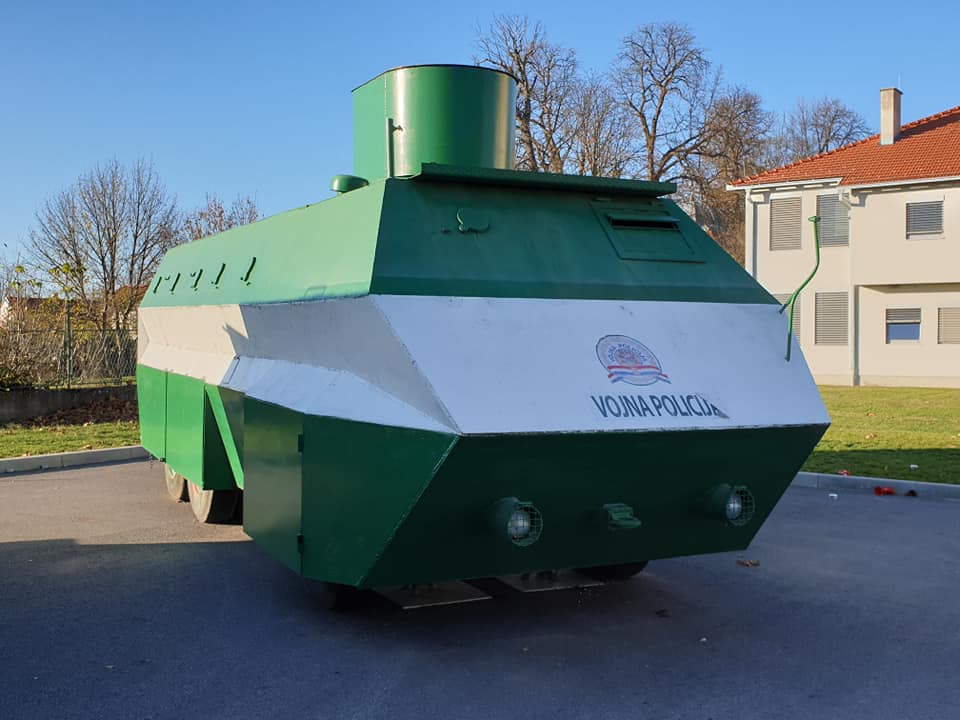
Improvised armoured carriers at their most basic.

The Mad Max version.
Lunch was a fascinating affair, as people of all ages and backgrounds mixed on the wooden benches in the tents. To my left, three veterans recalling how they could judge the impending impact from the differing sounds of howitzers, to my right, a conversation with a Vukovar-born member of the Ministry for Veterans Rights. It was a fascinating chat, one to be continued over coffee in Zagreb later this month.

Before leaving, the Trombunjeri had one obligation in a school. I followed them in and was struck by what I saw. This most divided of cities has a large population of both Serbs and Croats. School takes place for both communities in the same building but separate lessons, Latin script for the Croats, Cyrillic for the Serbs (this is the door for the Second Grade classroom). With so many open wounds and unserved justice, that division is completely understandable.
And yet I was thinking only of the boy and that face of abundant joy earlier in the day. How to keep that joy and move his generation forward to a better and more hopeful future?
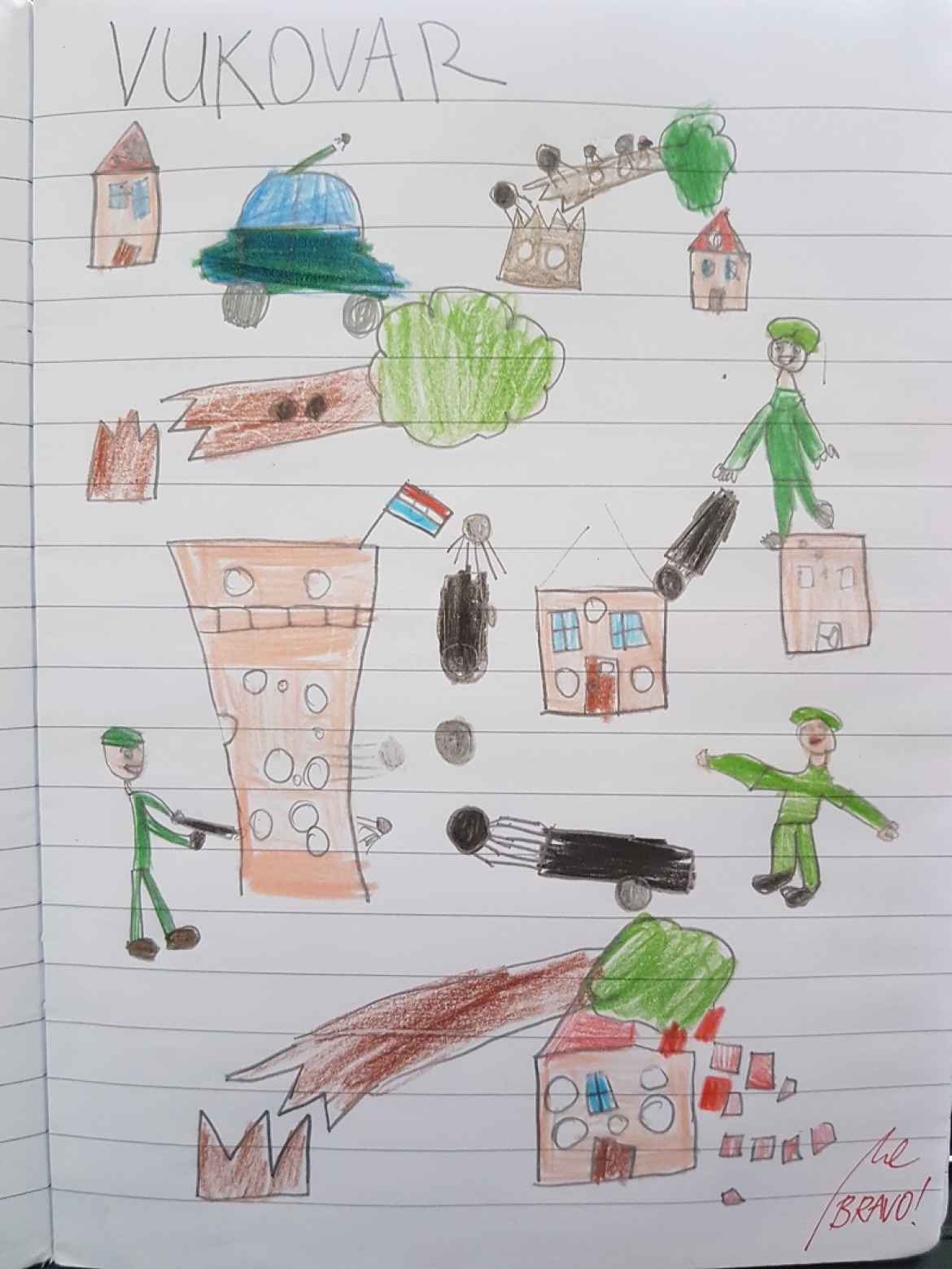
One of the things that shocked me as a foreign parent here was the homework given to 7-year-olds. My daughter got her first nightmare at the age of seven on November 19 of that year. It took me some time to figure out what had caused such distress, but then I learned about the homework. It is an incredibly difficult and emotive subject, and not one for a foreigner. But how do we remember and honour the past and move forward with the future from homework like the above to this, below?

I don't know. I don't even know if it is possible.

It would be easy to conclude from the media that Vukovar and the eastern region is a place of doom and gloom, but the truth is that it is absolutely fascinating, and there are so many incredible things here which can be developed. Directly across from the cemetery is one of them, one of the most sensational things in all Croatia, that very few people know about. Learn more in Vucedol Era: When Eastern Croatian Settlements Most Important in All Europe.
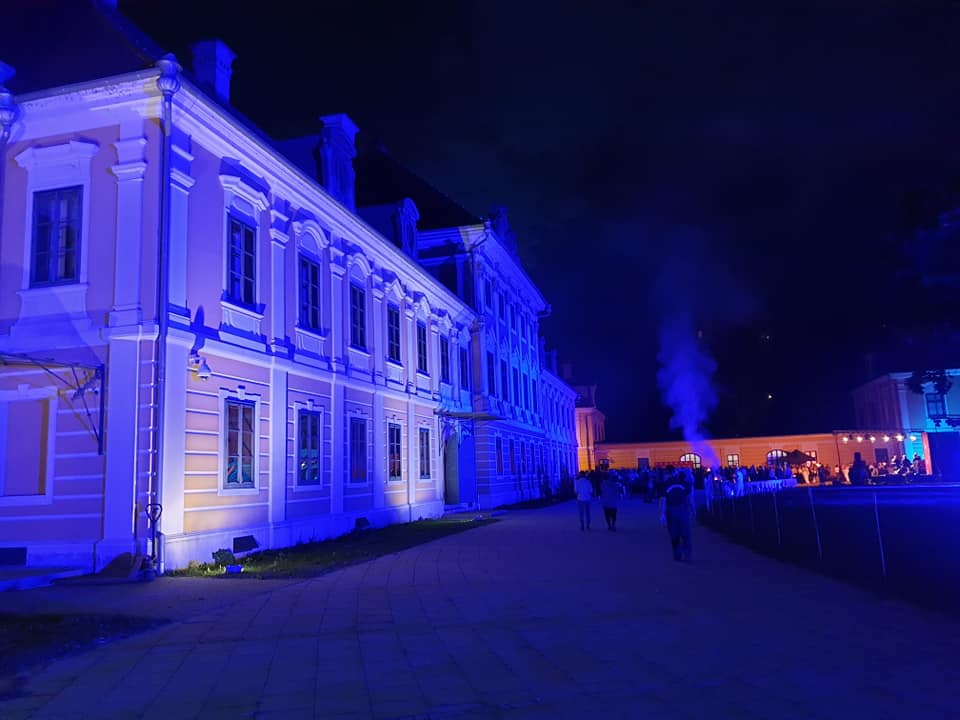
And for those who think that Vukovar is all ruined buildings, they are in for a big surprise, as this image of Eltz Palace from the recent Days of Croatian Tourism event shows.
The visit to Vukovar Remembrance Day was emotionally draining, but worth every effort. It also gave me one more layer of perspective on this fabulous but really complex country. My advice? Come and visit. Eastern Croatia is a wonderful place, the hospitality the warmest and most genuine in the whole country, and there is SO much to see and do. Here, for example, is how we filled an action-packed family weekend when we decided to Head On East.
And if you are looking to learn more about what Vukovar has to offer, here are 25 things to know.
After Vukovar, Foreign Veterans Gather in English Pub Near Vinkovci
November 18, 2019, the annual commemoration of the fall of Vukovar is a national event each year in Croatia. And in a small English pub in a field not far from Vukovar, the foreign veterans who served came together for a much lesser-known gathering. TCN was there. It was quite a night.
They came from all over the world - Sweden, Holland, Australia, the UK, France, Germany, Ireland, and Bolivia.
Total strangers, with just one thing in common - to volunteer to fight for the freedom of an independent Croatia.
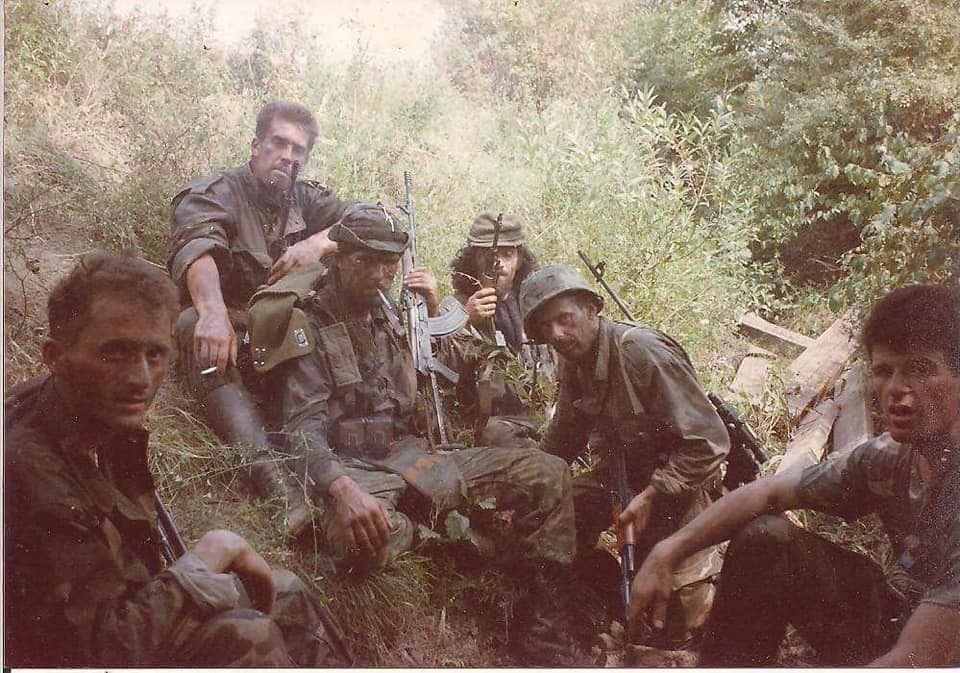
And last night, in an English pub in a field in the middle of nowhere in eastern Croatia, they gathered once again, some 28 years after first joining up to fight in the Homeland War.
The war changed them all emotionally, many physically. There were four eye patches covering missing eyes in four of the soldiers, and several of the others had difficulty walking due to the wounds inflicted during the conflict.
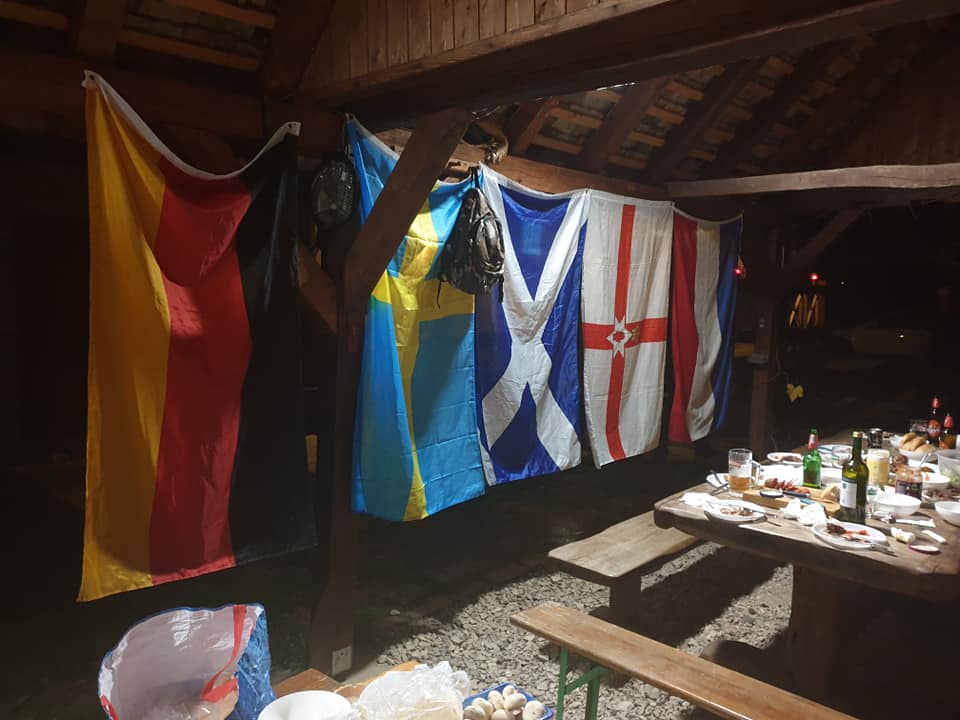
The foreign war veterans of Croatia's War of Independence, together again on November 18, the day of national remembrance for the fall of Vukovar, the most emotionally charged day in the Croatian calendar. I, like they, had spent the best part of the day walking the 6km from the hospital town in the centre of Vukovar, past the iconic water tower to a service of remembrance at the large Vukovar Memorial Cemetery. And after the emotions of the occasion, we all arrived independently at the English pub, The White Boar, which lies in a field close to the train tracks on the edge of the village of Andrijasevci near Vinkovci.
People often ask me how I find so many unique stories in Croatia. With so many unique things to tell and nobody telling them, it is actually fairly easy. The only thing you need is a curious mind and the courage to ask questions to find out more. And so it was this time. A few weeks ago, on my first visit to Vinkovci, I noticed a rather bizarre sight - a red British telephone box. Upon asking, I learned that a man from Leeds called Steve had brought it a few years ago. This Steve was a local Vinkovci legend, having volunteered to fight for Croatia, been wounded, then stayed to build a life in Vinkovci with his local wife. That life, I learned, included opening an English pub in this empty field. Intrigued, I went to find the pub, only to find it closed. Steve was kind enough to agree to an email interview, and I really encourage you to read How I Came to Open an English Pub in a Field in Eastern Croatia.
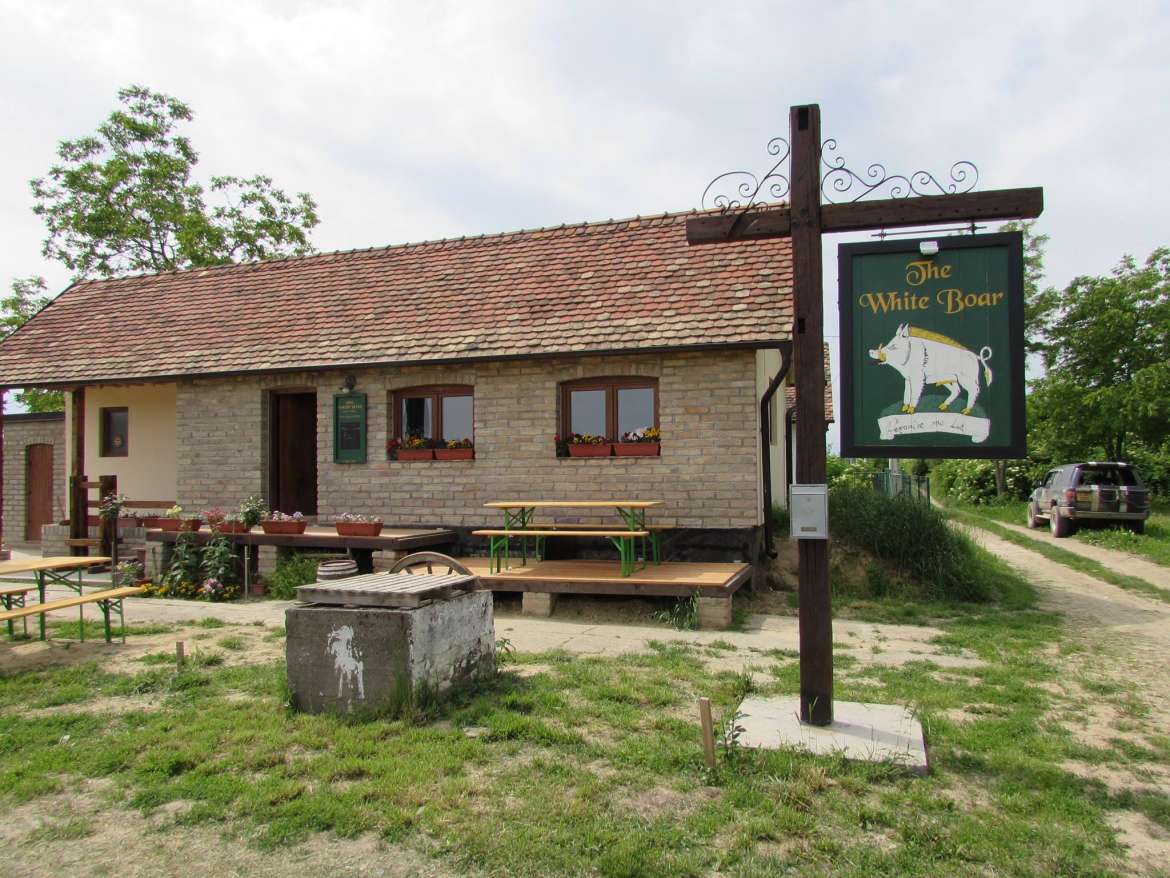
During the interview, Steve mentioned he only has draught beer for special occasions, such as November 18, when all the foreign vets come to party after the official programme in Vukovar.
Wait, what? All the foreign vets in an English pub in the middle of nowhere in eastern Croatia - now this was a story that had potential.
But I was an outsider. When I was an aid worker after the genocide in Rwanda in 1994, I was acutely aware that I could not understand everything as I had been an outsider. Similarly with life in Croatia, for I was not even here during the war. And as fascinating as it would be to hear the stories of these brave men who gave so much to Croatia, it was more than likely that they would resent the presence of an outsider at their private gathering, let alone want to talk to a journalist.
Nothing could have been further from the truth. I sounded Steve out about the possibility of me visiting, and he responded that it was a great idea, and the evening of the 18th was the absolutely best time to visit - to share in the happiness of reunion after the sadness of the day.
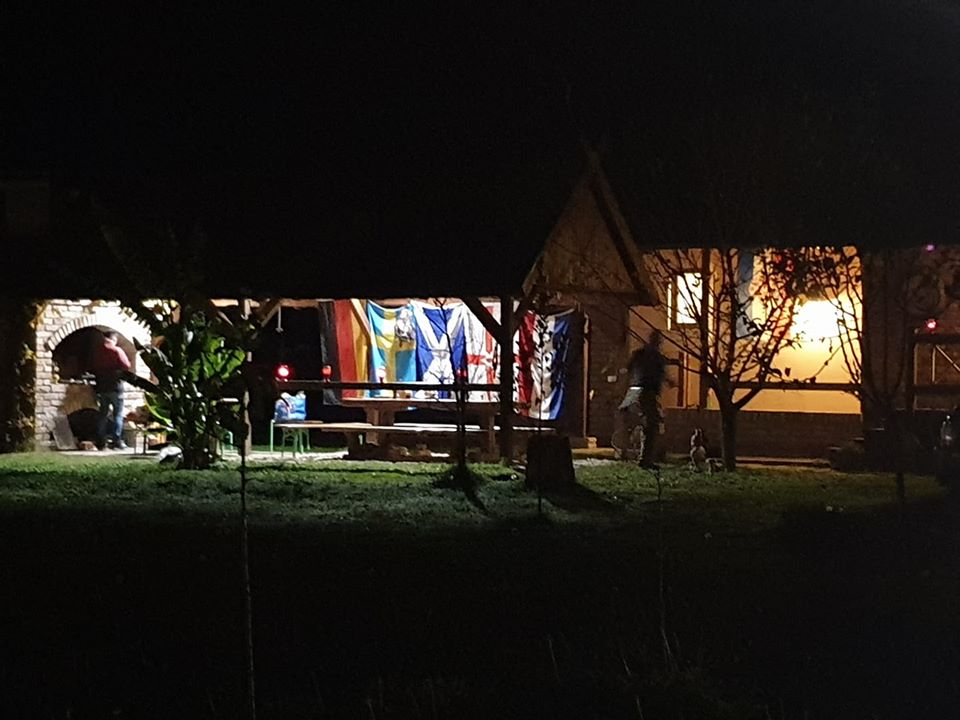
I went with a friend and was a little nervous as I approached, seeing all the flags and the vets in their battle fatigues, but two things put me immediately at rest. The first was the warm welcome from Steve and his family, who were grateful for the articles I had written about the pub.
And the second was a message of greetings I passed on to one British veteran called Rod from a friend of mine on Hvar, Vivian Grisogono, who had met Rod in the course of her work during the war. Rod was surprised that Vivian even remembered his name (and it clearly meant a lot that someone had remembered his service and suffering) and was very touched when I read him the part of the email in which she detailed that memory. He replied with memories of his own about my friend - how Vivian had pressed £10 into his hand once in London when he was short of money and insisted he keep it. He became quite emotional.
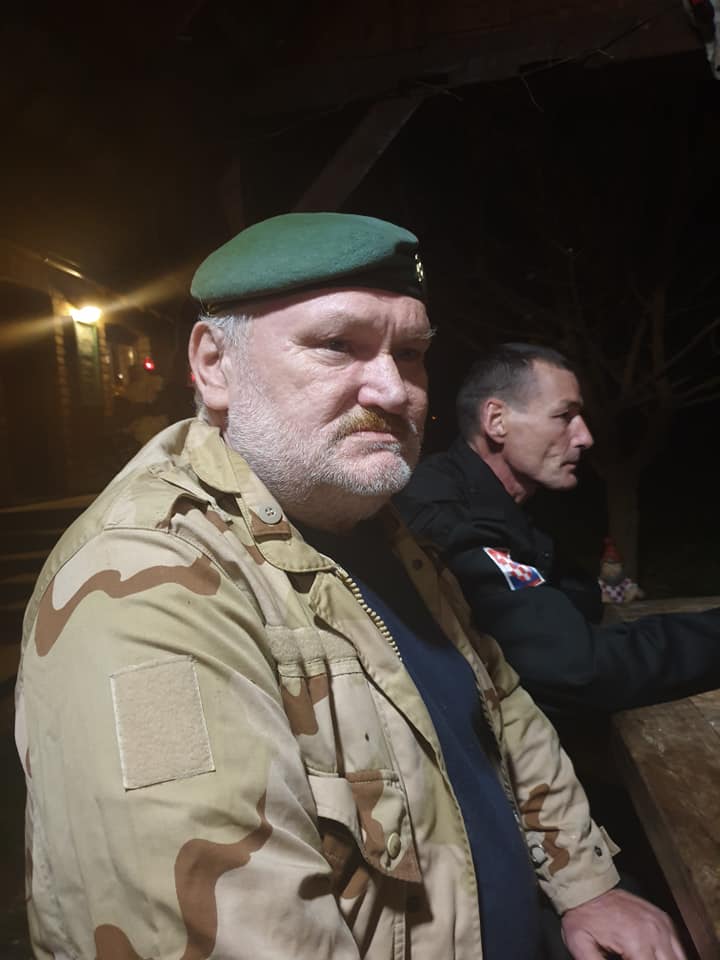
Out of respect, I had decided not to write anything about the event unless they were comfortable with that - I was gatecrashing a private party after all. But if they wanted to talk, I was there to relay their words - their memories, hopes, disappointments and reflections.
And so began a fascinating evening, but not one which ended last night in terms of reporting, for several of these foreign fighters are keen to be featured a little more, for despite their heroics, they feel that there is little recognition of the sacrifices they have made, or assistance with the ongoing battles some face, especially those living in Croatia.
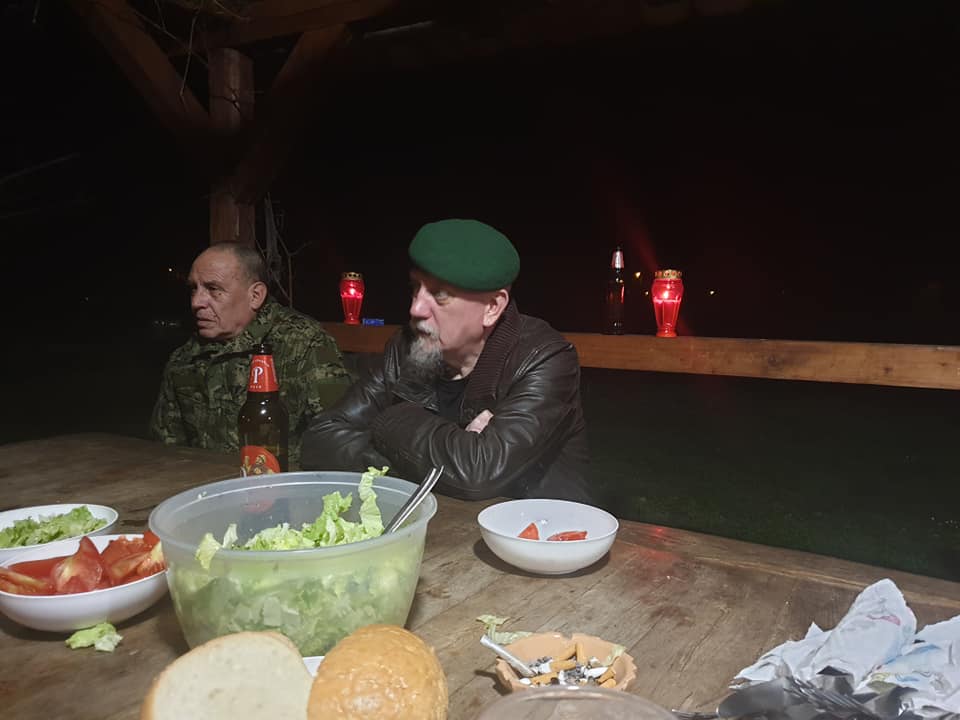
One heart-wrenching story came from one vet now living in a small town in continental Croatia. Wounded five times during the war, he can no longer walk unaided. He received an apartment and pension after the war back in 1999, and was classified as being 70% invalid. He has an illness which has been aggravated by his injuries, but rather than receiving more help, he is getting less. His invalid status has been reduced to first 60%, then 50%, and his pension now is 55% less than it once was, as the ministry looks to cut costs. This, he observed with some bitterness, when there are over half a million veterans in Croatia today, a number which increases year on year. The result of his reduced income, he says, is that he has barely enough to survive on, and 3-4 days a month, nothing to eat.
I had not realised that the percentage of disability affects things such as access. Another vet told me that he and this 50% invalid vet had got to the cemetery at 07:30 to get there before the crowds. He himself is an 80% invalid, but they were turned away in their car. Only 100% invalids were allowed through, so they had to turn their car, find some parking down a dirt path and add a painful additional 500 metres to their journey.

But there was also plenty of laughter, and I particularly enjoyed the dark humour that came from their war year experiences, as well as the fabulous stories of how they got involved in the first place. Were they all altruistic volunteers, or some mercenary, some spies? It was impossible for me to tell on such a short meeting, but what shone through from all of them was the pride in their sacrifice, their love of Croatia, and the honour and memories of those that stepped up when Croatia needed it most.
Small stories, seemingly inconsequential in the larger picture, that stayed with these brave men. Of one who was wounded and treated behind the front line by a Croatian doctor who had returned from a successful practice in Germany to play his part. At his side was his nurse wife, while their 7-year-old daughter was mopping his brow and doing her best to make him comfortable. That female touch in that very masculine environment meant the world to him then, as it does today.
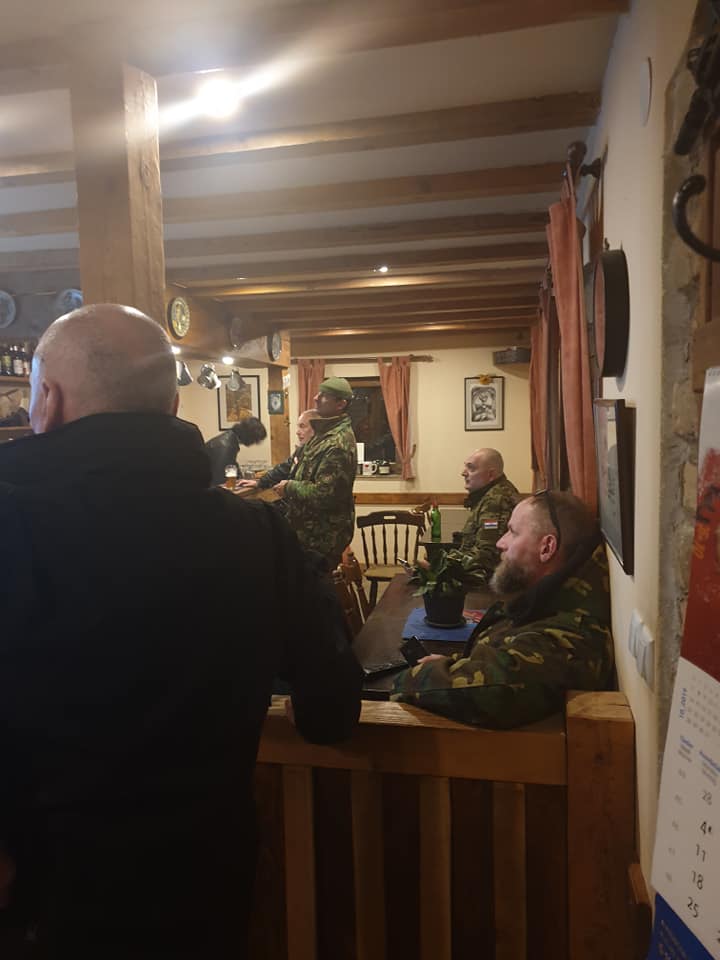
One decided with a friend to fight for Croatia while living in Taiwan. His only Croatian friend there was an exotic dancer, who gave them a gold watch a client had given her. She told him to pawn the watch to pay for their flights - her contribution to her motherland's war effort.
For some, Vukovar is an annual event, a chance to remember fallen friends and to catch up with those who went through the same hell as they, but for others, last night was the first return to Croatia in over a decade. And for one British vet in particular, it was an incredibly emotional return.
He had decided to visit some of the towns and villages in Bosnia where he had fought. Walking around one, he was recognised by a local who had fought with him in his unit. An emotional reunion led to coffee, rakija, beer, and then a question.
"Have you ever been to Johan's grave? Would you like to see it if not?"
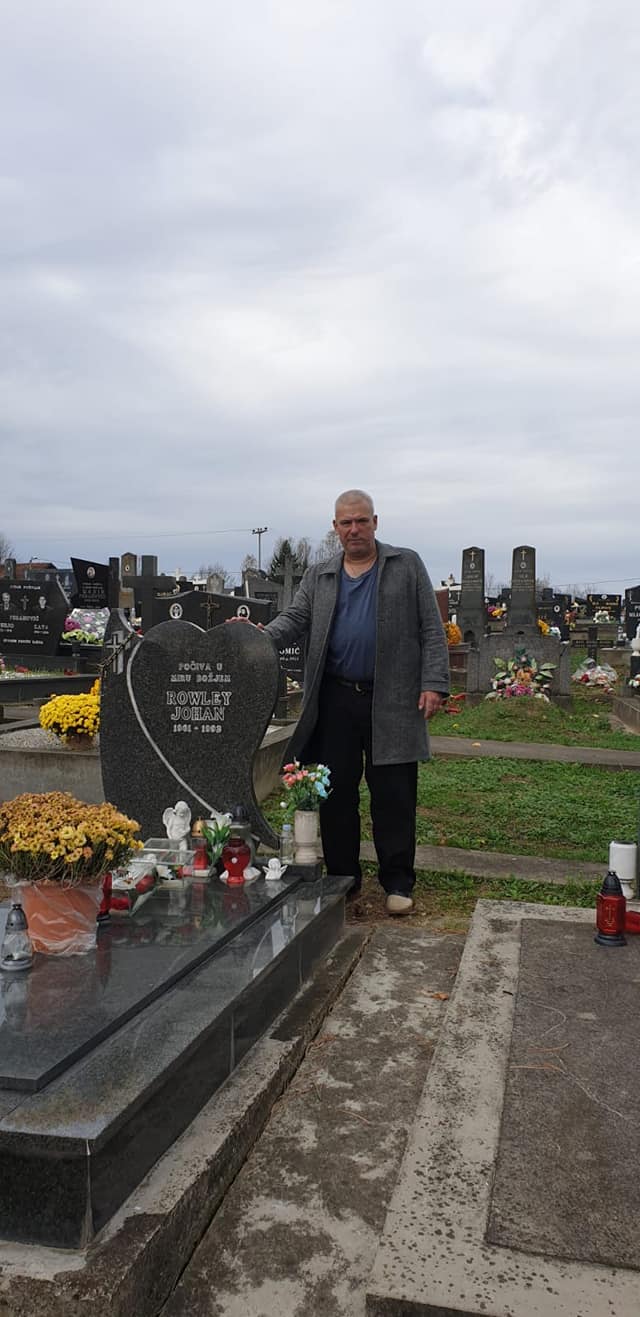
Memories came flooding back. Johan was another foreign vet who had been wounded at least twice. For twice was the number he had carried Johan on his back to safety. On the last occasion, Johan was really struggling, six bullets inside him, and he somehow kept going to carry Johan back to relative safety. As they were almost there, Johan took a seventh bullet, the blood spraying all over his rescuer. They made it to the field hospital, where Johan was patched up and sent down the line where he sadly died two hours later.
And now, some 26 years later, the chance to visit his grave. A hugely emotional moment, made all the more so when he saw how well Johan's grave had been looked after. A marble top and fresh flowers. He touched the cold marble grave and got some kind of closure.
Some time before the Vukovar event, the Office of the President got in touch with these foreign veterans requesting a meeting during the official programme. A publicity stunt during an election campaign, perhaps, but it was a request which was well received, for the majority of those I spoke to last night feel very disappointed by the way they have been marginalised after the service they gave. In the event, the presidential meeting was a total failure. As the veterans waited for their moment, a presidential aid was insisting that the President had no time to meet them as she was on a tight schedule. In the end, she did apparently come for a few seconds, but nothing of consequence was said. Another disappointment.
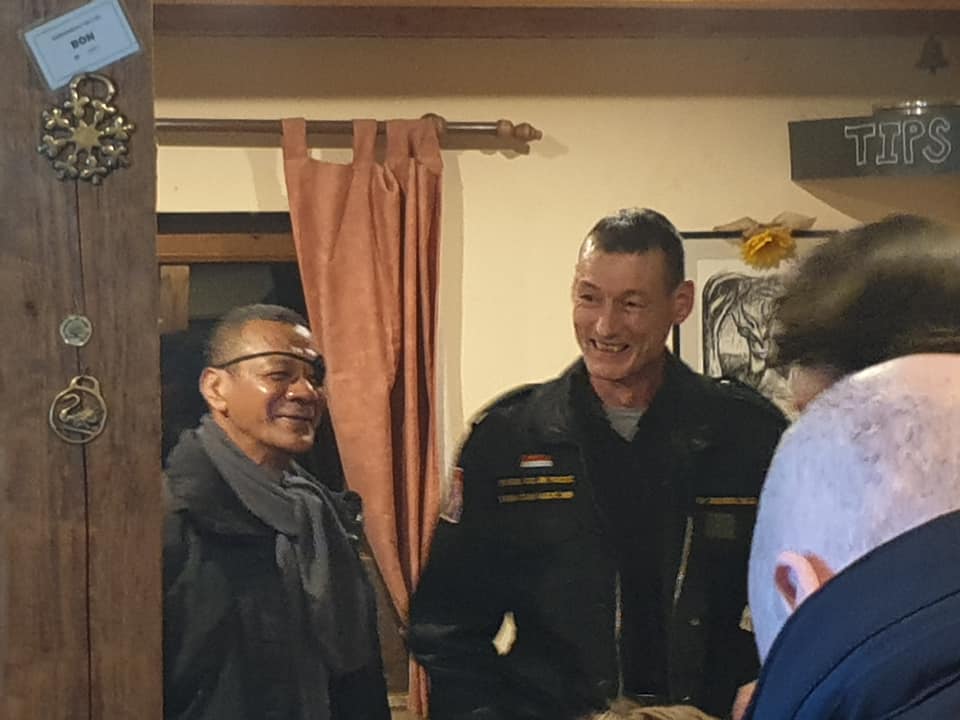
There is more, much more that I could write about last night. And I will, but another time.
My visit to Vukovar was emotionally draining, and I was not even involved. What it must be like for these heroes, living it and the consequences of it on a daily basis, I can only imagine.
I sincerely hope they receive the recognition and support that they deserve, and TCN's door is always open for those who want to highlight such stories.
I went for a walk on my own. So much to take in. And when I returned, my favourite band in the world (see video above) were playing. The Smiths and This Charming Man in an English pub in a field in the middle of nowhere in eastern Croatia with a barbecue with foreign volunteers in Croatia's Homeland War. As random as life can be.
It was an honour to be there.
Thank you for your considerable contributions.


